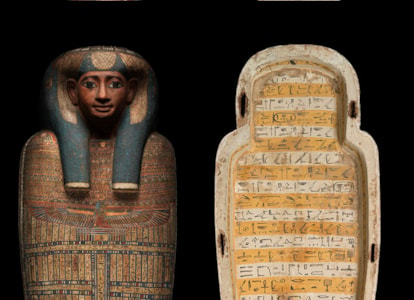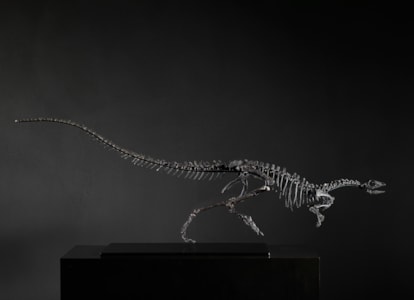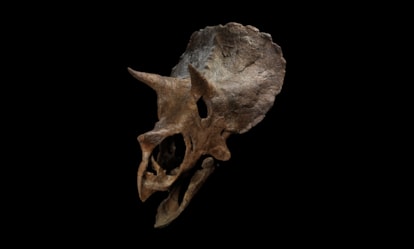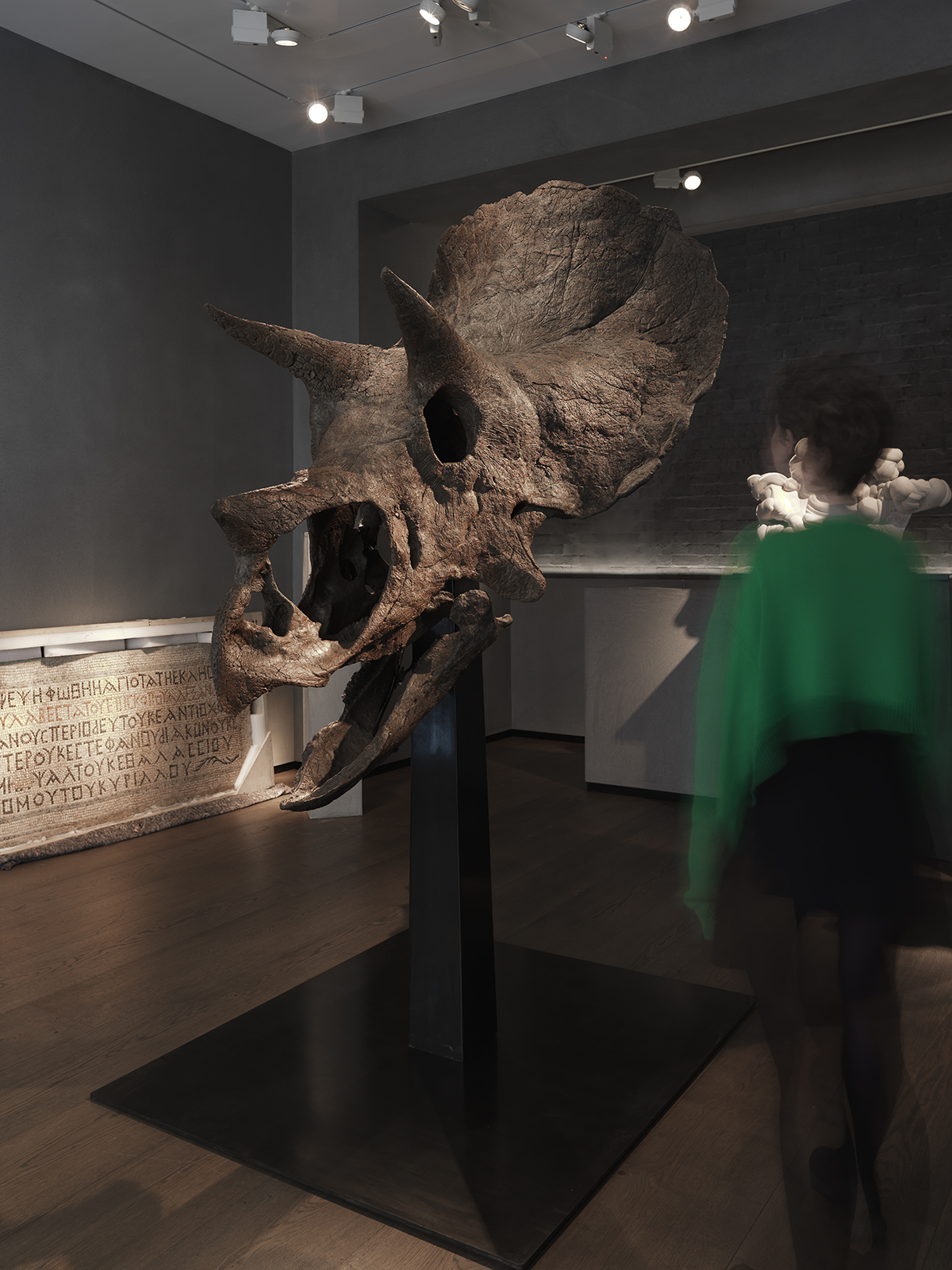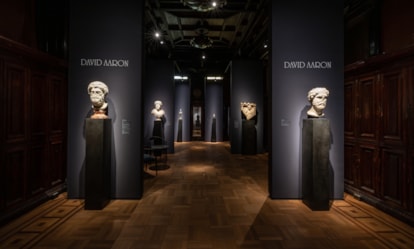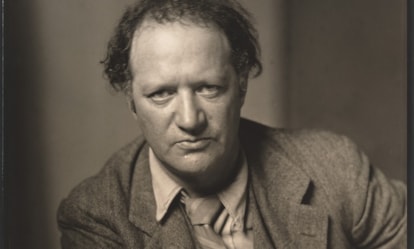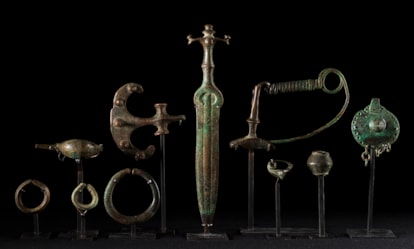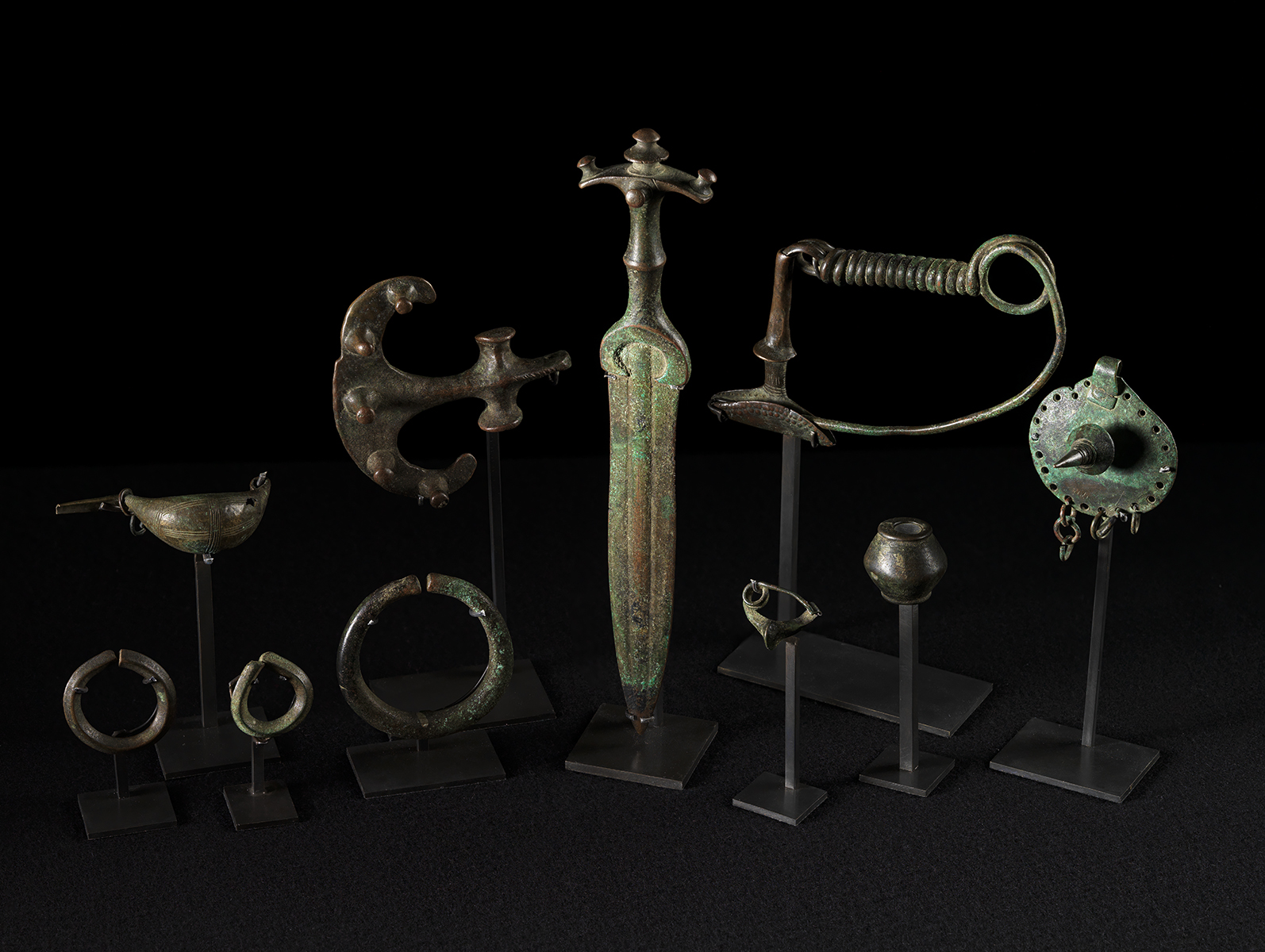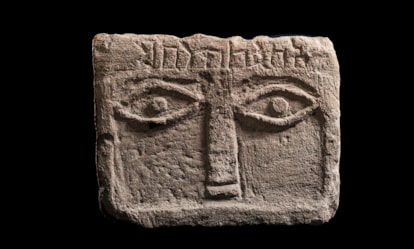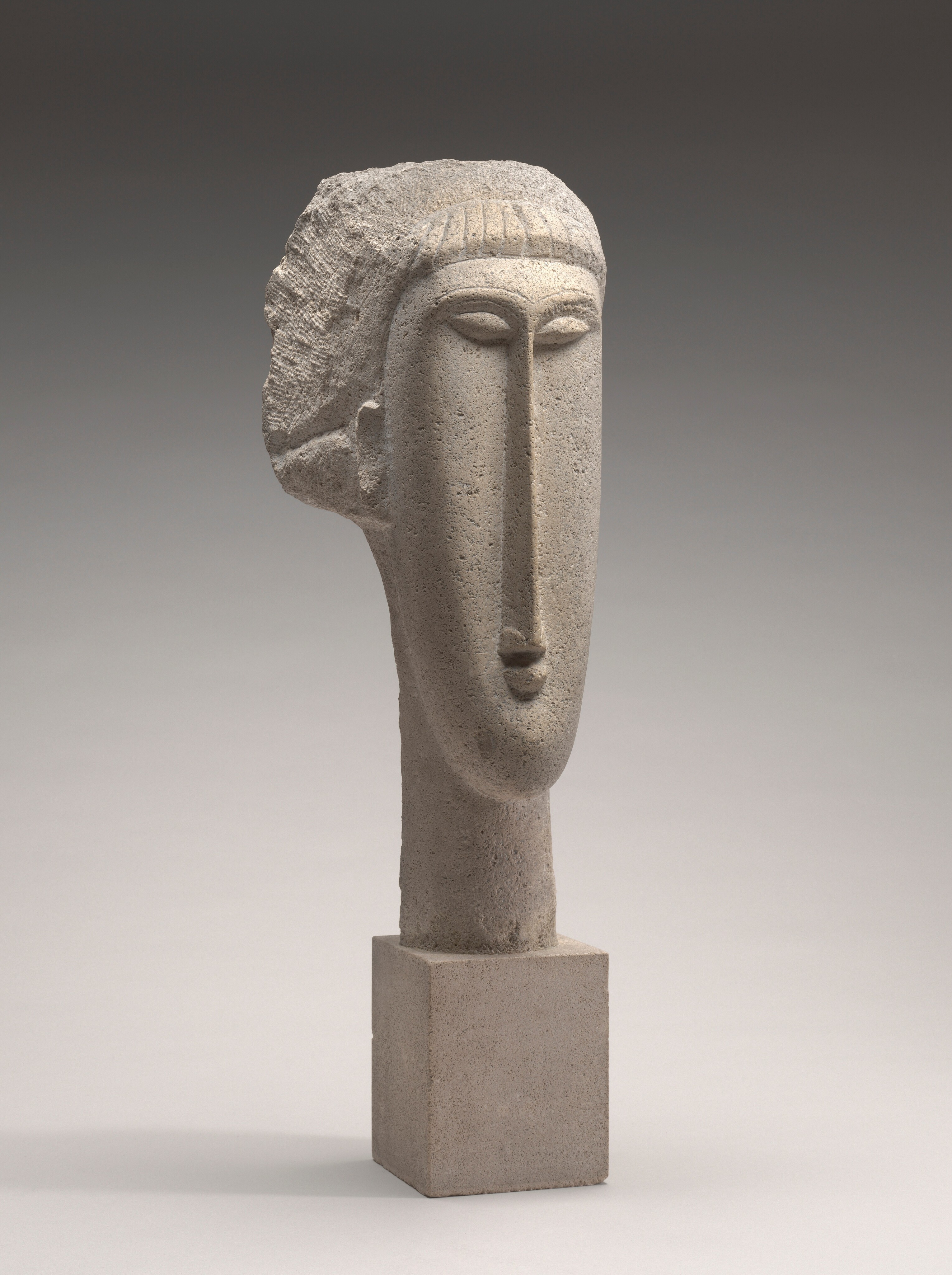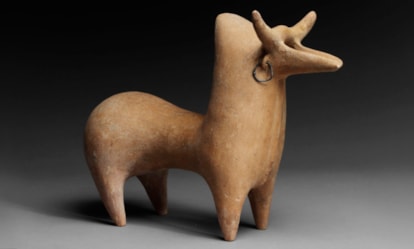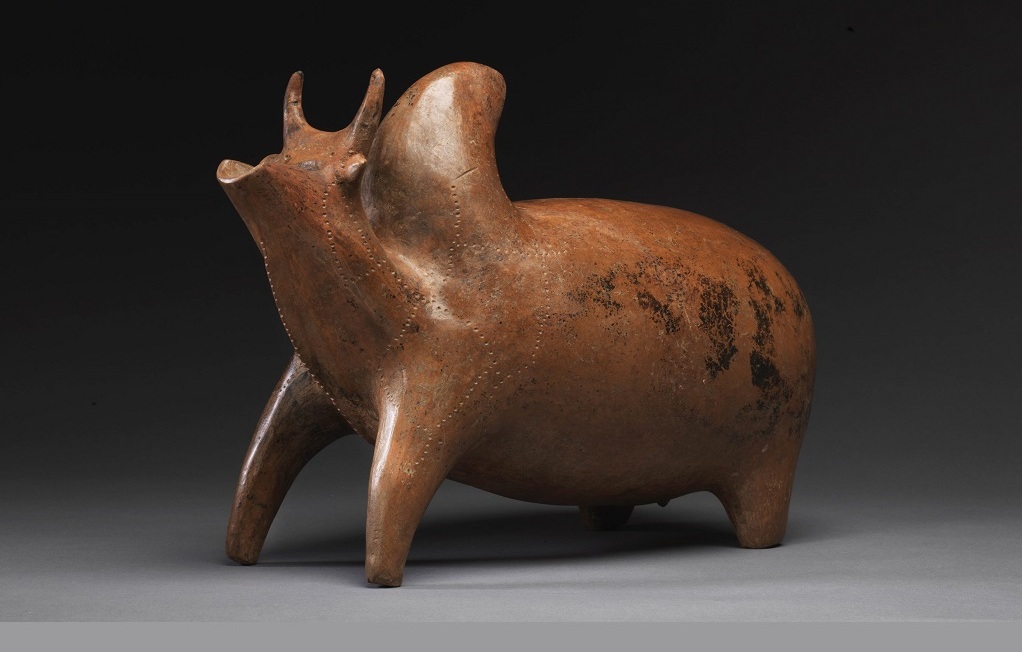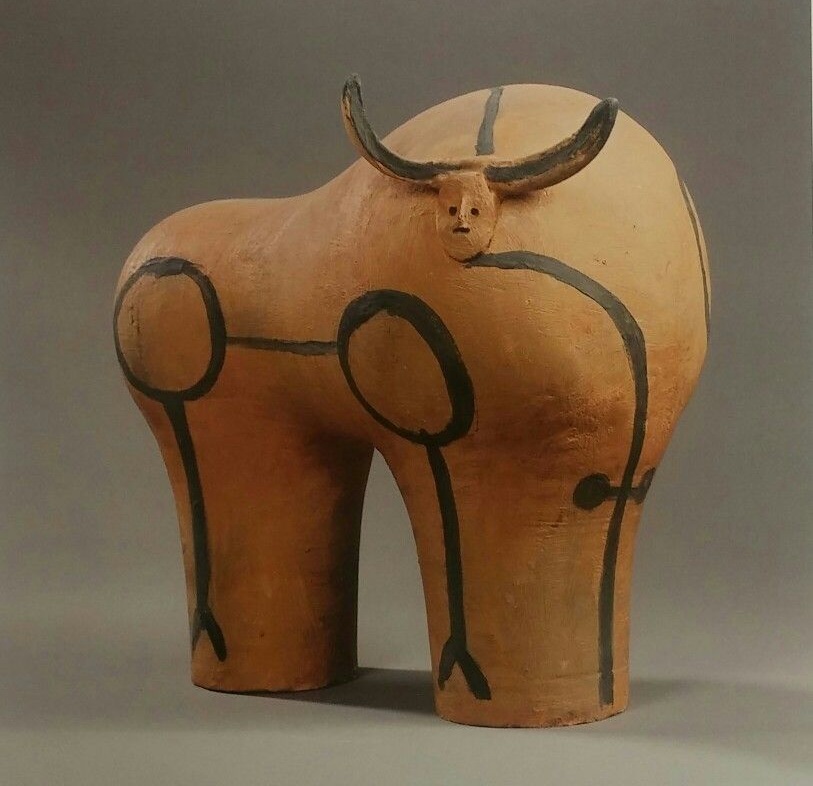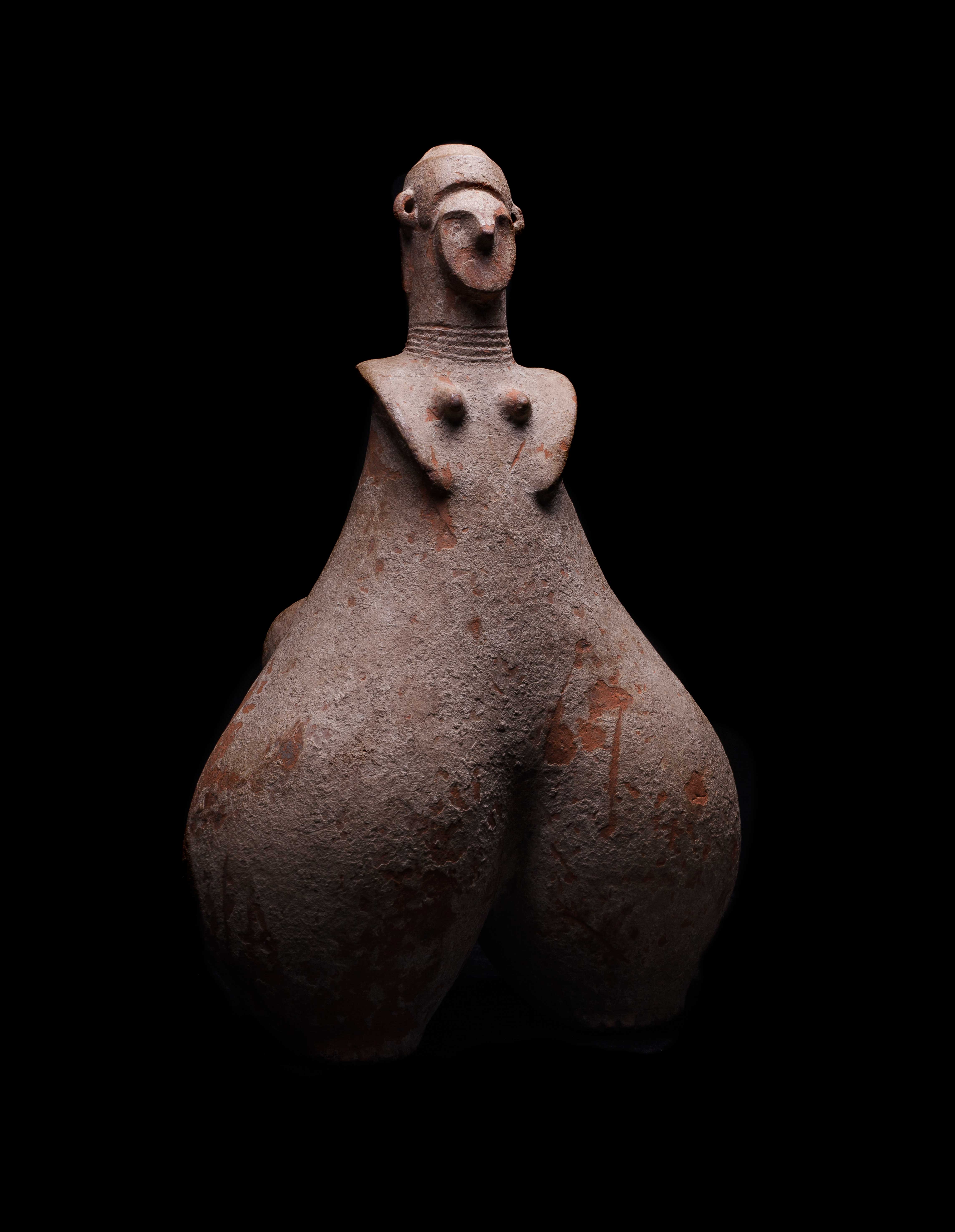Journal
FRIEZE Masters: 2025
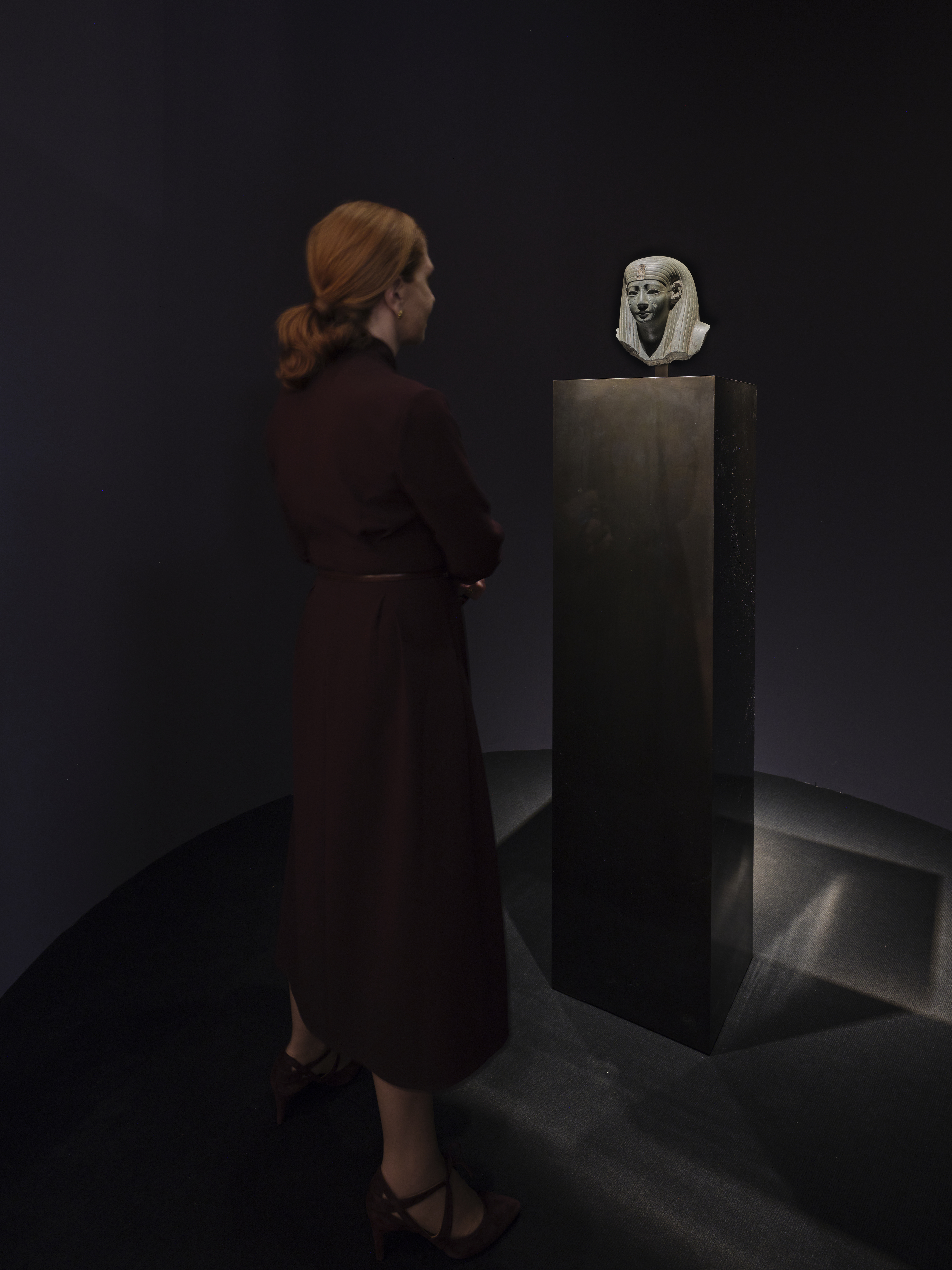
The Goddess by a Greywacke Master, an important Egyptian bust dating from the Reign of Pharaoh Amasis, circa 570 – 526 B.C
Our exhibition highlight was The Goddess by the Greywacke Master, an exquisite example of Egyptian sculpture attributed to an anonymous artist, the Greywacke Master, and dated to the reign of Amasis (c. 570-526 B.C.). The piece captivated visitors with its presence, fine detail and intriguing provenance from misattribution to rediscovery.
Published 21/10/2025
Read time: 2min
Last week marked our fifth year exhibiting at Frieze Masters. Here at David Aaron, we were delighted to return to Regent’s Park for one of the most anticipated events in the London art calendar.
Our stand, designed by Crawford and Grey, presented a carefully curated selection of works of ancient art and natural history. Greeting visitors at the entrance to the stand was a sub-adult Triceratops skull, which drew significant attention from collectors, curators, and the press alike. The specimen, offered at £650,000, sold on the Fair’s opening night, underscoring the continued global demand for rare and scientifically important fossils.

The Goddess by a Greywacke Master, an important Egyptian bust dating from the Reign of Pharaoh Amasis, circa 570 – 526 B.C
Our exhibition highlight was The Goddess by the Greywacke Master, an exquisite example of Egyptian sculpture attributed to an anonymous artist, the Greywacke Master, and dated to the reign of Amasis (c. 570-526 B.C.). The piece captivated visitors with its presence, fine detail and intriguing provenance from misattribution to rediscovery.
The fair also saw extensive media interest in our presentation. Our stand was featured in international outlets including Observer, ArtNews, Elle Decor Italia, FAD Magazine, and The Art Newspaper. Throughout the week, the stand was consistently busy, with visitors captivated by the stories behind each piece and the fascinating provenance of our works.
“Frieze Masters is always a pleasure to be part of. It is an exciting fair that draws an interesting, and, interested crowd of collectors, curators and art enthusiasts.” Salomon Aaron, Director
We would like to thank Emanuela Tarizzo, Director of Frieze Masters, as well as everyone at FRIEZE, Stabilo and all the contractors who worked tirelessly to bring our stand to life. We look forward to returning next year to continue sharing our passion for exceptional works from the ancient and natural worlds.
“Frieze Masters is always a pleasure to be part of. It is an exciting fair that draws an interesting, and, interested crowd of collectors, curators and art enthusiasts.” Salomon Aaron, Director
We would like to thank Emanuela Tarizzo, Director of Frieze Masters, as well as everyone at FRIEZE, Stabilo and all the contractors who worked tirelessly to bring our stand to life. We look forward to returning next year to continue sharing our passion for exceptional works from the ancient and natural worlds.
The Forgotten Princess
In 2025, the coffin is once again on public display, this time as part of the Making Egypt exhibition at the Young V&A, where visitors can view this exceptional object in person. Its presence not only brings ancient history into focus, but also underlines the value of sustained research, conservation, and responsible curation in the rediscovery of lost narratives.
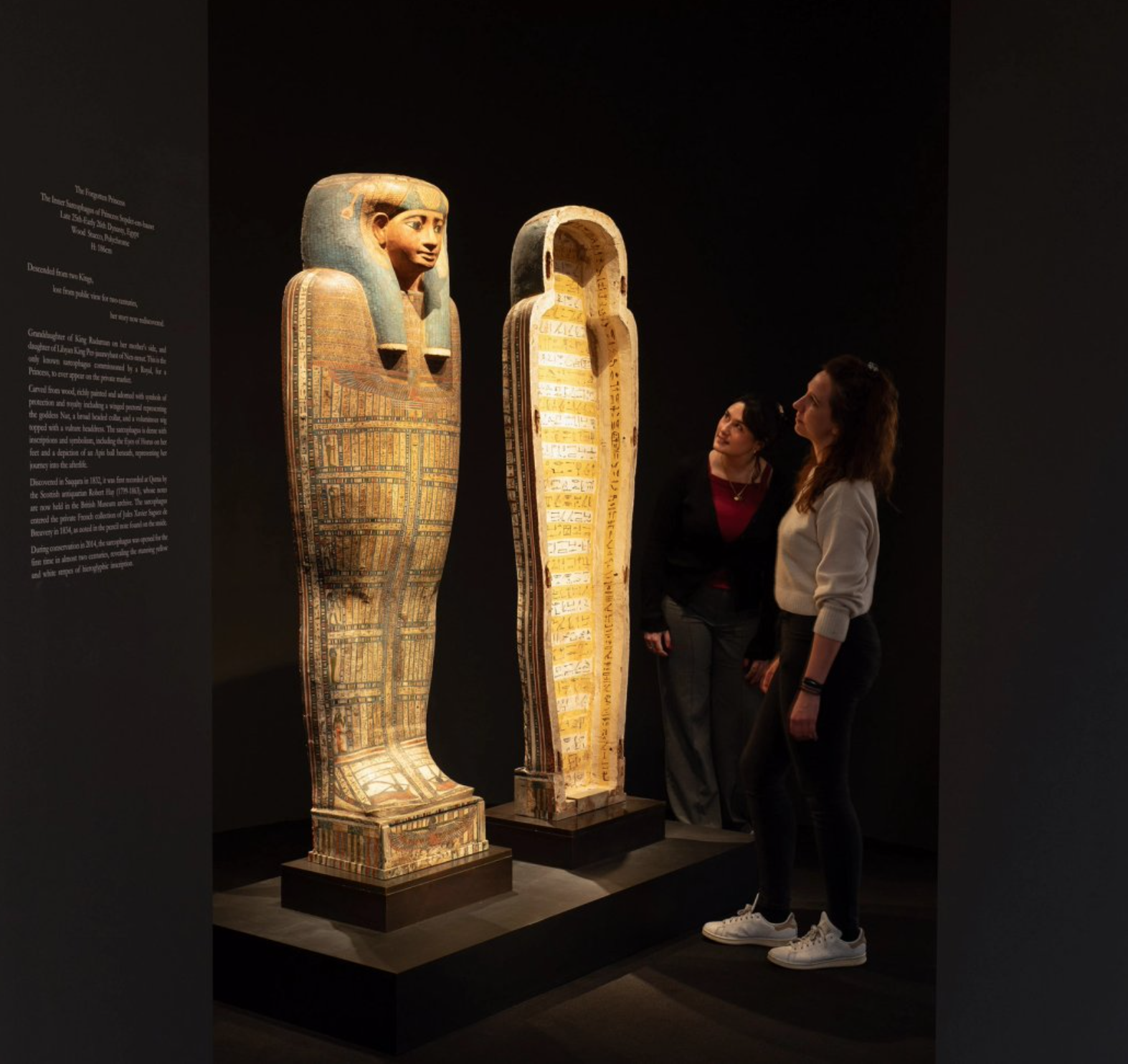
The Forgotton Princess on display at Frieze Masters, 2024. Photo credit David Owens / co The Art Newspaper
The Forgotten Princess: Early Egyptologists
In 2014, a handwritten note was found on the inner base of the coffin, dating back to the early nineteenth-century:
‘Decouverte à Sakara en 1832 / rapportée d’egypte par M J de Breuv[ery] / En 1834’ (‘Discovered in Saqqara in 1832, removed from Egypt by M. J de Breuvery in 1834’)
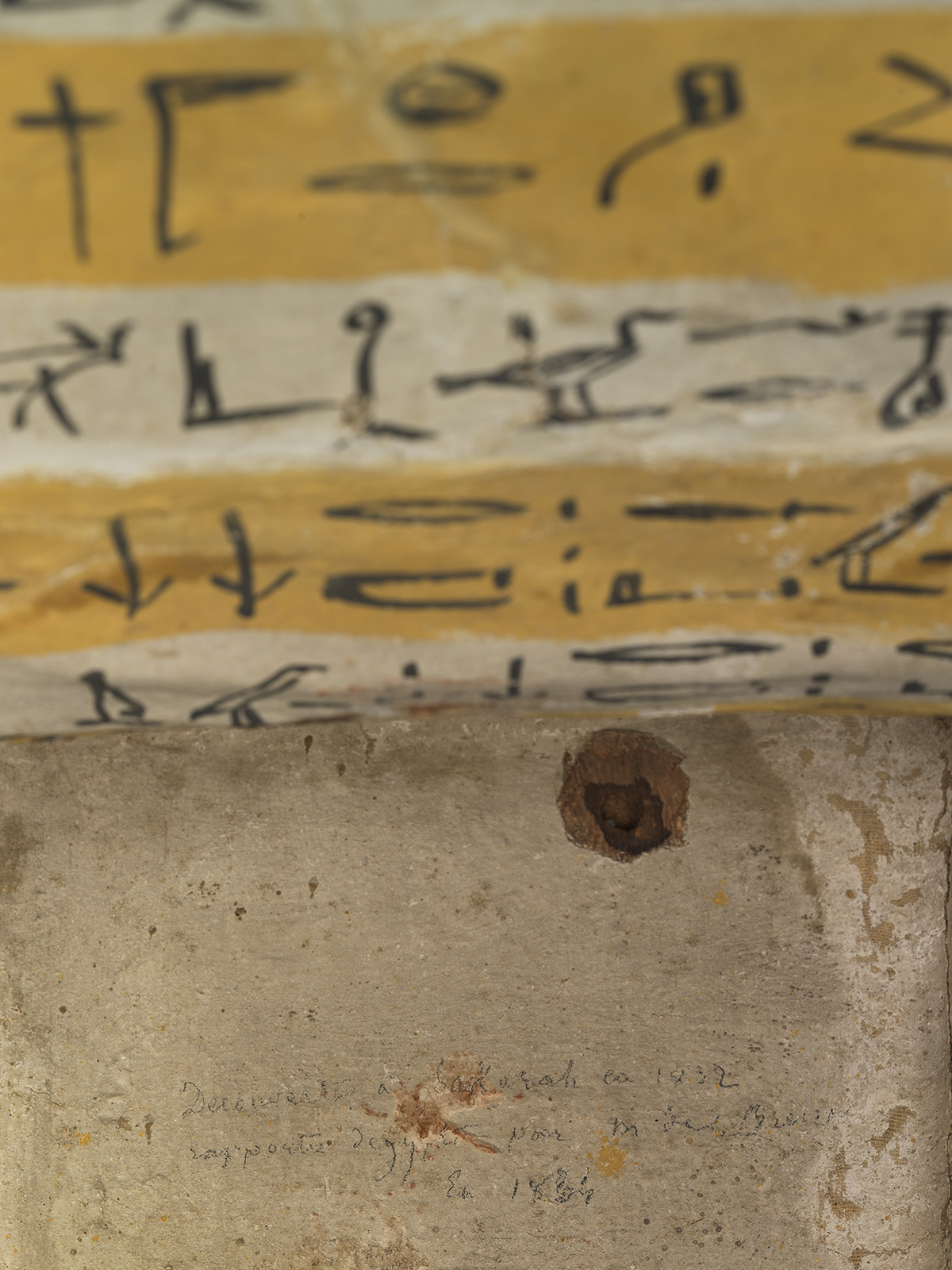
The handwritten note can be seen on the inside of the base of the coffin.
The ‘M J Breuv[ery]’ in the note is Monsieur Jules Xavier Saguez de Breuvery (1805-1876), a French archaeologist who travelled the Near East, Egypt and Sudan with Édouard Pierre Marie de Cadalvène, between 1829 and 1832. De Breuvery and de Cadalvène published an account of their journey in four volumes, including their social and political commentary on the Ottoman Empire.
In 1829, de Breuvery and de Cadalvène began their journey through Egypt at Alexandria. They spent some time in the city, visiting sites such as Pompey’s Pillar and Cleopatra’s Needles. From here, they set out to Rosetta and Fuwwah, before continuing on to Damietta, where they began their journey down the Nile. Whilst staying in Cairo, the pair toured the pyramids of Giza, Heliopolis, and other notable regions from antiquity. They continued on to Faiyum and to the famous tombs at Beni Hasan, then down towards Abydos, Qurna, where they travelled to the temple at Denderra, before arriving at Thebes:
"Before us lay the immense plain which the ancient metropolis of Egypt covered with its countless buildings. Here and there rose on both banks of the Nile these gigantic ruins before which our republican phalanxes clapped their hands or presented arms, by a spontaneous movement, as if these ruins communicated an involuntary enthusiasm, as if they had a language intelligible to all." (translated) J. de Breuvery and Ed. de Cadalvène, L’Égypte et La Nubie (Paris, 1841), pp. 310-11
They explored much of the region around Thebes, visiting the temple at Karnak, the Ramesseum, the Valley of Kings, Medinet Habu, El-Assassif, and the city of Luxor. They sailed down the Nile past the temples of Esna, Edfu, and Kom Ombo, and through Aswan and Elephantine into what is now Sudan. Their tour then passed through Khartoum, Gebel Adda, Wadi Halfa, and Dongola, to Kordofan. From Kordofan they returned northwards, back to Saqqara. De Breuvery and de Cadalvène’s comprehensive itinerary reveals their keen interest in Egypt and its ancient history, and they even took care to describe the condition of the antiquities they saw on their route.
De Breuvery made several purchases of antiquities during their journey, several of which were inscribed with similar handwritten notes recording the dates he acquired them. Among the objects he brought back to his home at Saint-Germain-en-Laye in France are a caryatide statue from Halicarnassus (Musée du Louvre, Paris, MNC 1382) and the coffin of Princess Sopdet-em-haawt.
De Breuvery and de Cadalvène met many contemporary Egyptologists, archaeologists, and other travellers during their travels. For instance, they met famous explorer and early Egyptologist Robert Hay (1799-1863) at Beni Hasan.
"Mr. Hay, a wealthy English traveller and enthusiastic admirer of Egyptian architecture, was at Beny-Hassan when we arrived, busy carefully drawing the hieroglyphic paintings which decorate the speos of the mountain." (translated) De Breuvery and de Cadalvène, L’Égypte et La Nubie, p. 431.
Hay transcribed the paintings on the Speos Artemidos into one of his meticulous notebooks, where he also recorded a portion of the inscriptions on the coffin of Princess Sopdet-em-haawt. Hay recorded the coffin between 1829 and 1834, when he was living in the village of Gournah in the Theban area. Hay’s drawings, paintings, plans, notebooks and diaries are now in the collection of the British Library, including this notebook (Add.MSS.29827, fol. 83 verso).
Modern Rediscovery
In December 2013, the coffin was sold at Sotheby’s, New York. At this time, the coffin had remained closed, and the details of the internal hieroglyphics and the pencil note remained undiscovered. Still, the coffin had already sparked the interest of several scholars.
In 2009, when the coffin’s whereabouts were not public knowledge and using only the transcribed inscription in Hay’s notebook, Raphaële Meffre traced the lineage of Princess Sopdet-em-haawt in her article ‘Une Princesse Héracléopolitaine de l’Époque Libyenne: Sopdet(em)haaout’ (Revue d’Égyptologie, 60 (2009), pp. 215-221). As a descendant of two Libyan kings, the princess’s coffin can be dated to either the very end of the 25th Dynasty or, more likely, the beginning of the 26th. Sopdet-em-haawt was married to a member of one of the most important Theban families; her husband was involved in the cults of Amun and of Montu, whose priests were among the most influential people in Thebes from the end of the Libyan Period to the 26th Dynasty.
However, it was not until 2014 when the coffin was painstakingly cleaned, conserved, and opened by conservators that much of the internal hieroglyphs became visible, and the incredibly well-preserved striped interior inscriptions were uncovered. The new discoveries prompted Meffre to study the coffin in greater detail. In 2015, she published a complete, 54-page translation of the coffin’s internal and external inscriptions (‘Le cercueil intérieur de la princesse Sopdet-em-hââout et la famille des rois Roudamon et Peftjaouâuybastet’, Monuments et mémoires de la Fondation Eugène Piot, 94 (2015), pp. 7-59).
The Princess Sopdet-em-haawt lived during a pivotal regime shift between the end of the Third Intermediate Period and the establishment of the Late Period. Her coffin is highly important in expanding our knowledge of workshops in the Theban area at the beginning of the Late Period. This, alongside the extremely well-preserved decoration, given new life through extensive conservation, and the rediscovered nineteenth-century provenance, makes the coffin of Sopdet-em-haawt a truly unique example of an ancient Egyptian coffin on the market today.
Making Egypt - Exhibition at Young V&A
The coffin of Princess Sopdet-em-haawt is on view as part of Making Egypt, the major new exhibition at the Young V&A, running until 2 November 2025. The exhibition offers a rare chance to examine the coffin's beautifully preserved decoration up close, including the striking internal yellow and white stripes, and reflects on how ancient Egypt has influenced art, design and popular culture today.

The inner sarcophagus of Princess Sopdet-em-haawt on view as part of Making Egypt, Young V&A, 2025. Courtesy Victoria and Albert Museum, London. Photo: David Parry
Published 18/07/2025
Read time: 4min
In 2014, the inner coffin of Princess Sopdet‑em‑haawt was opened for the first time in nearly two centuries. Inside, conservators discovered extensive heiroglyphics painted on wonderfully preserved bright-yellow and white stripes, as well as a handwritten note from the early 1830s.
As we begin preparations for Frieze Masters 2025, we wanted to take a moment to reflect on one of the stand-out pieces from our stand last year, a rediscovered royal coffin that attracted widespread public and media interest.
Exhibited under the title 'The Forgotten Princess', the coffin was the centrepiece for our Frieze Masters 2024 display. Its presence drew significant attention, not only for its beauty and intricate detailing, but because it is the only known royal Egyptian sarcophagus to have appeared on the art market.
As we begin preparations for Frieze Masters 2025, we wanted to take a moment to reflect on one of the stand-out pieces from our stand last year, a rediscovered royal coffin that attracted widespread public and media interest.
Exhibited under the title 'The Forgotten Princess', the coffin was the centrepiece for our Frieze Masters 2024 display. Its presence drew significant attention, not only for its beauty and intricate detailing, but because it is the only known royal Egyptian sarcophagus to have appeared on the art market.
In 2025, the coffin is once again on public display, this time as part of the Making Egypt exhibition at the Young V&A, where visitors can view this exceptional object in person. Its presence not only brings ancient history into focus, but also underlines the value of sustained research, conservation, and responsible curation in the rediscovery of lost narratives.

The Forgotton Princess on display at Frieze Masters, 2024. Photo credit David Owens / co The Art Newspaper
The Forgotten Princess: Early Egyptologists
In 2014, a handwritten note was found on the inner base of the coffin, dating back to the early nineteenth-century:
‘Decouverte à Sakara en 1832 / rapportée d’egypte par M J de Breuv[ery] / En 1834’ (‘Discovered in Saqqara in 1832, removed from Egypt by M. J de Breuvery in 1834’)

The handwritten note can be seen on the inside of the base of the coffin.
The ‘M J Breuv[ery]’ in the note is Monsieur Jules Xavier Saguez de Breuvery (1805-1876), a French archaeologist who travelled the Near East, Egypt and Sudan with Édouard Pierre Marie de Cadalvène, between 1829 and 1832. De Breuvery and de Cadalvène published an account of their journey in four volumes, including their social and political commentary on the Ottoman Empire.
In 1829, de Breuvery and de Cadalvène began their journey through Egypt at Alexandria. They spent some time in the city, visiting sites such as Pompey’s Pillar and Cleopatra’s Needles. From here, they set out to Rosetta and Fuwwah, before continuing on to Damietta, where they began their journey down the Nile. Whilst staying in Cairo, the pair toured the pyramids of Giza, Heliopolis, and other notable regions from antiquity. They continued on to Faiyum and to the famous tombs at Beni Hasan, then down towards Abydos, Qurna, where they travelled to the temple at Denderra, before arriving at Thebes:
"Before us lay the immense plain which the ancient metropolis of Egypt covered with its countless buildings. Here and there rose on both banks of the Nile these gigantic ruins before which our republican phalanxes clapped their hands or presented arms, by a spontaneous movement, as if these ruins communicated an involuntary enthusiasm, as if they had a language intelligible to all." (translated) J. de Breuvery and Ed. de Cadalvène, L’Égypte et La Nubie (Paris, 1841), pp. 310-11
They explored much of the region around Thebes, visiting the temple at Karnak, the Ramesseum, the Valley of Kings, Medinet Habu, El-Assassif, and the city of Luxor. They sailed down the Nile past the temples of Esna, Edfu, and Kom Ombo, and through Aswan and Elephantine into what is now Sudan. Their tour then passed through Khartoum, Gebel Adda, Wadi Halfa, and Dongola, to Kordofan. From Kordofan they returned northwards, back to Saqqara. De Breuvery and de Cadalvène’s comprehensive itinerary reveals their keen interest in Egypt and its ancient history, and they even took care to describe the condition of the antiquities they saw on their route.
De Breuvery made several purchases of antiquities during their journey, several of which were inscribed with similar handwritten notes recording the dates he acquired them. Among the objects he brought back to his home at Saint-Germain-en-Laye in France are a caryatide statue from Halicarnassus (Musée du Louvre, Paris, MNC 1382) and the coffin of Princess Sopdet-em-haawt.
De Breuvery and de Cadalvène met many contemporary Egyptologists, archaeologists, and other travellers during their travels. For instance, they met famous explorer and early Egyptologist Robert Hay (1799-1863) at Beni Hasan.
"Mr. Hay, a wealthy English traveller and enthusiastic admirer of Egyptian architecture, was at Beny-Hassan when we arrived, busy carefully drawing the hieroglyphic paintings which decorate the speos of the mountain." (translated) De Breuvery and de Cadalvène, L’Égypte et La Nubie, p. 431.
Hay transcribed the paintings on the Speos Artemidos into one of his meticulous notebooks, where he also recorded a portion of the inscriptions on the coffin of Princess Sopdet-em-haawt. Hay recorded the coffin between 1829 and 1834, when he was living in the village of Gournah in the Theban area. Hay’s drawings, paintings, plans, notebooks and diaries are now in the collection of the British Library, including this notebook (Add.MSS.29827, fol. 83 verso).
Modern Rediscovery
In December 2013, the coffin was sold at Sotheby’s, New York. At this time, the coffin had remained closed, and the details of the internal hieroglyphics and the pencil note remained undiscovered. Still, the coffin had already sparked the interest of several scholars.
In 2009, when the coffin’s whereabouts were not public knowledge and using only the transcribed inscription in Hay’s notebook, Raphaële Meffre traced the lineage of Princess Sopdet-em-haawt in her article ‘Une Princesse Héracléopolitaine de l’Époque Libyenne: Sopdet(em)haaout’ (Revue d’Égyptologie, 60 (2009), pp. 215-221). As a descendant of two Libyan kings, the princess’s coffin can be dated to either the very end of the 25th Dynasty or, more likely, the beginning of the 26th. Sopdet-em-haawt was married to a member of one of the most important Theban families; her husband was involved in the cults of Amun and of Montu, whose priests were among the most influential people in Thebes from the end of the Libyan Period to the 26th Dynasty.
However, it was not until 2014 when the coffin was painstakingly cleaned, conserved, and opened by conservators that much of the internal hieroglyphs became visible, and the incredibly well-preserved striped interior inscriptions were uncovered. The new discoveries prompted Meffre to study the coffin in greater detail. In 2015, she published a complete, 54-page translation of the coffin’s internal and external inscriptions (‘Le cercueil intérieur de la princesse Sopdet-em-hââout et la famille des rois Roudamon et Peftjaouâuybastet’, Monuments et mémoires de la Fondation Eugène Piot, 94 (2015), pp. 7-59).
The Princess Sopdet-em-haawt lived during a pivotal regime shift between the end of the Third Intermediate Period and the establishment of the Late Period. Her coffin is highly important in expanding our knowledge of workshops in the Theban area at the beginning of the Late Period. This, alongside the extremely well-preserved decoration, given new life through extensive conservation, and the rediscovered nineteenth-century provenance, makes the coffin of Sopdet-em-haawt a truly unique example of an ancient Egyptian coffin on the market today.
Making Egypt - Exhibition at Young V&A
The coffin of Princess Sopdet-em-haawt is on view as part of Making Egypt, the major new exhibition at the Young V&A, running until 2 November 2025. The exhibition offers a rare chance to examine the coffin's beautifully preserved decoration up close, including the striking internal yellow and white stripes, and reflects on how ancient Egypt has influenced art, design and popular culture today.

The inner sarcophagus of Princess Sopdet-em-haawt on view as part of Making Egypt, Young V&A, 2025. Courtesy Victoria and Albert Museum, London. Photo: David Parry
Notable Sale: Enigmacursor Joins the Natural History Museum
Published 25/06/2025
Read time: 2min
David Aaron is proud to announce the sale of a newly identified dinosaur species to the Natural History Museum, London. First exhibited at Frieze Masters in 2023, and identified as a Nanosaurus, this exceptional Late Jurassic skeleton has since been reclassified as a previously unknown species and genus, an Enigmacursor, which means “the enigmatic runner.”
"The sale of this extraordinary skeleton to the Natural History Museum is a true honour," says Salomon Aaron, director of David Aaron. "This specimen allows for further important research into what we understand about dinosaur species and adds a significant chapter to the Museum's rich tapestry of natural history."

The Enigmacursor on display at the Natural History Museum, London. (Image credit: Lucie Goodayle, The Natural History Museum)

Conservation and analysis of the Enigmarcusor taking place at the Natural History Museum (Image credit: The Natural History Museum)
"The sale of this extraordinary skeleton to the Natural History Museum is a true honour," says Salomon Aaron, director of David Aaron. "This specimen allows for further important research into what we understand about dinosaur species and adds a significant chapter to the Museum's rich tapestry of natural history."

The Enigmacursor on display at the Natural History Museum, London. (Image credit: Lucie Goodayle, The Natural History Museum)
Excavated in 2021–22 on the Skull Creek site in Moffat County, Colorado, the fossil quickly attracted attention for its completeness, detail and size. With a mounted length of just over 180 cm, it appeared at first to match descriptions of Nanosaurus, long considered one of the smallest dinosaurs of the Jurassic period.
But following in depth research led by the Natural History Museum’s palaeontology team, the specimen has now been confirmed as a distinct and newly recognised species. It is also thought there are signs that the dinosaur was not fully grown, says co-lead research author Professor Paul Barrett.
“One feature we look at in dinosaurs are the neural arches,” Paul explains. “These are the top section of vertebrae, and form separately from the lower parts. They gradually merge as an animal gets older, so by examining them you can see whether it was still growing.”
But following in depth research led by the Natural History Museum’s palaeontology team, the specimen has now been confirmed as a distinct and newly recognised species. It is also thought there are signs that the dinosaur was not fully grown, says co-lead research author Professor Paul Barrett.
“One feature we look at in dinosaurs are the neural arches,” Paul explains. “These are the top section of vertebrae, and form separately from the lower parts. They gradually merge as an animal gets older, so by examining them you can see whether it was still growing.”

Conservation and analysis of the Enigmarcusor taking place at the Natural History Museum (Image credit: The Natural History Museum)
The acquisition has received widespread media coverage, including features by the BBC and the Evening Standard to name a few. This important addition to the museum’s internationally respected dinosaur collection not only enriches our understanding of small herbivorous dinosaurs in the Late Jurassic but also underscores the dynamic nature of palaeontological research, where each discovery has the potential to reshape what we think we know.
We are honoured to have played a part in the journey of this rare fossil and proud to have helped it find its permanent home in the halls of the Natural History Museum.
We are honoured to have played a part in the journey of this rare fossil and proud to have helped it find its permanent home in the halls of the Natural History Museum.
Walking with Maple: A Real Triceratops in Mayfair
Published 27/05/2025
Read time: 3min
This Sunday marked the return of the BBC’s acclaimed natural history docuseries Walking with Dinosaurs, with the premiere of its second season. The episode followed Clover, a young triceratops navigating the perils of prehistoric North America, including a dramatic encounter with a fully grown Tyrannosaurus rex.
Dinosaurs, with their awe-inspiring scale and dramatic mass extinction, continue to capture the public imagination like few other subjects. They are both nostalgic and timeless, igniting a sense of wonder across generations. From popular culture to cutting-edge palaeontology, dinosaurs consistently draw global attention, both in science and the arts.
Among them, few are as instantly recognisable as the Triceratops. With its broad bony frill, parrot-like beak and three distinctive facial horns, it has become an icon of prehistoric life. The genus name means “three-horned face”, and the creature’s appearance is both formidable and strangely endearing.
The first known remains of a Triceratops were discovered in 1887 in Colorado. Initially believed to belong to a species of extinct bison, the fossilised horns were re-identified by American palaeontologist Othniel Charles Marsh, who formally described Triceratops horridus in 1889 and Triceratops prorsus in 1890. A fully mounted skeleton, named Hatcher, the first to go on display, was later unveiled by the Smithsonian Institution in 1905 and remains one of the centrepieces of their dinosaur collection.
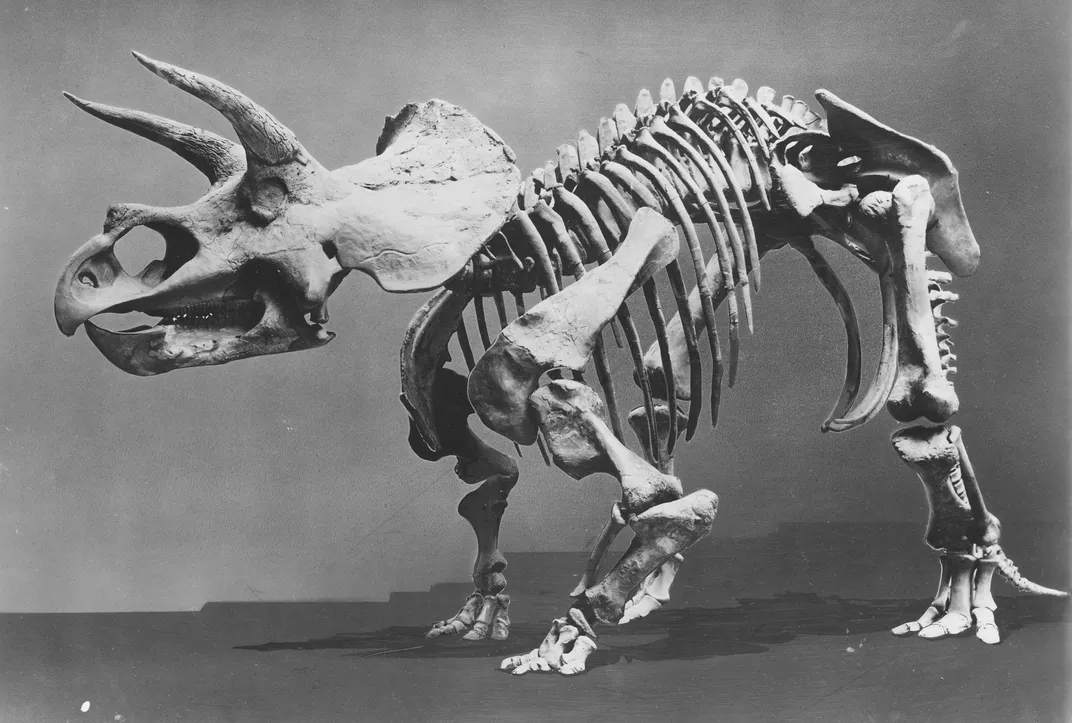
Hatcher, the first mounted and exhibited Triceratops, went on display in 1905, Smithsonian Institution.
At our gallery on Berkeley Square, we are privileged to host a real Triceratops skull; an extraordinary specimen named Maple. Estimated to be from a sub-adult, nearing full maturity, Maple’s skull measures a remarkable 181 cm from jaw to frill. It is believed that Triceratops reached full maturity around ten years of age, making juvenile and subadult fossils particularly scarce.
Maple was discovered in 2019 in the fossil-rich badlands of Montana and excavated throughout 2020. Following discovery, the skull underwent meticulous preparation, including expert conservation and reconstruction.
Palaeontologists assess age not only by size but also by the development of certain cranial features such as epoccipitals, small bony projections that line the top edge of the frill. These ridges, along with bone texture and suture fusion, help scientists estimate growth stages and age at death.
We were honoured to exhibit Cera, a smaller juvenile Triceratops, closer in size to the BBC's Triceratops Clover at Frieze Masters in 2022, which had these epoccipital bones still visible, where it received notable attention, including a feature in The Art Newspaper. The overwhelming public and media interest affirmed what we already knew- dinosaurs are as culturally relevant today as they were 66 million years ago.
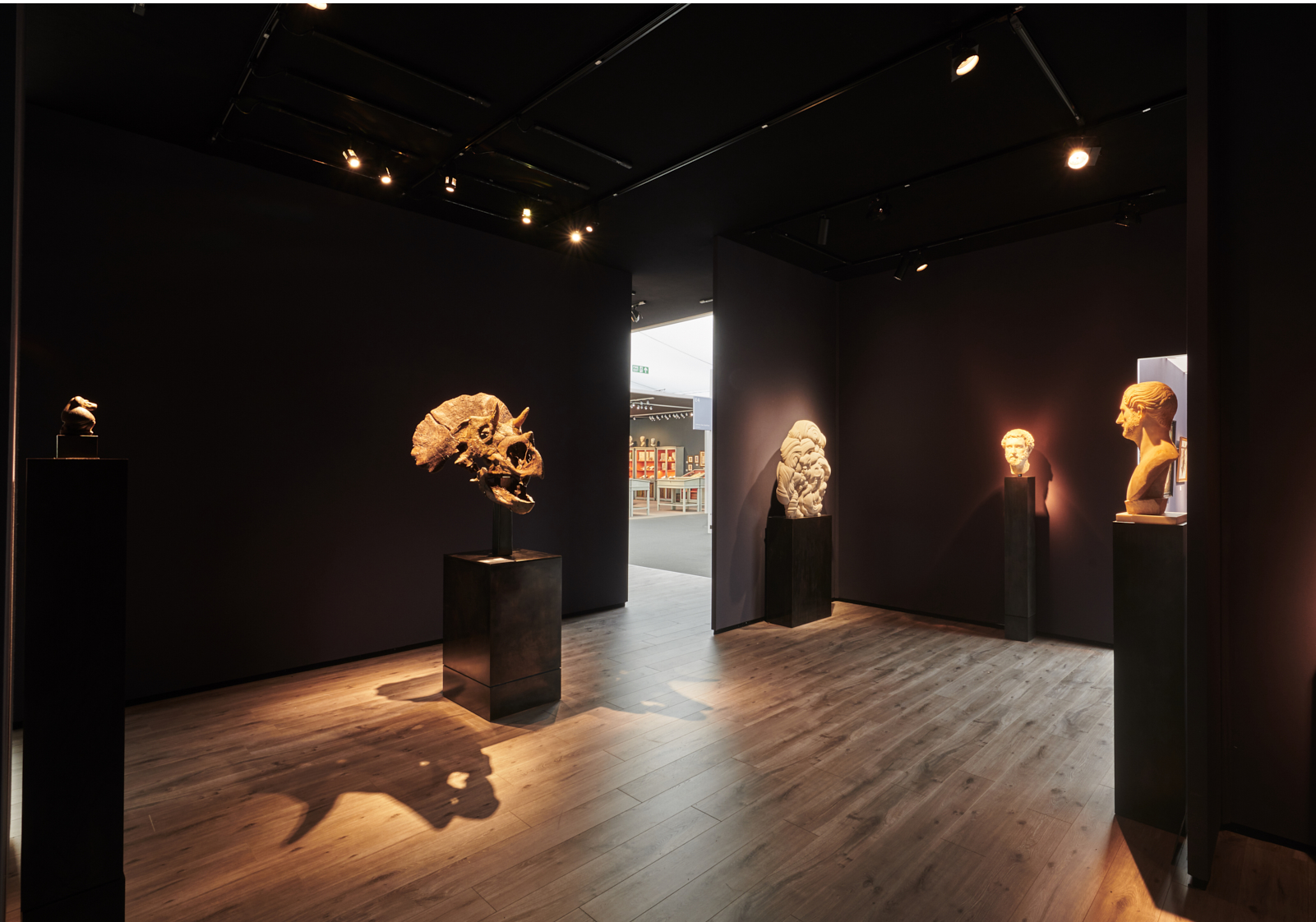
'Cera', A smaller example of a 'Juvenile Triceratops Skull' on show at Frieze Masters, London, in 2022. David Aaron Ltd
Triceratops is known for having had one of the largest skulls of any land animal in history. "It took up about a quarter of its whole body length, which is an unbelievably big skull," notes Dr Paul Barrett, palaeontologist at the Natural History Museum.
Today, fragments of Triceratops fossils are housed in museums and private collections around the world. However, few offer the opportunity to come face-to-face with a skull as complete and striking as Maple’s.
If you are in Mayfair, we welcome you to visit our gallery and experience this extraordinary piece of natural history in person. Maple is waiting.
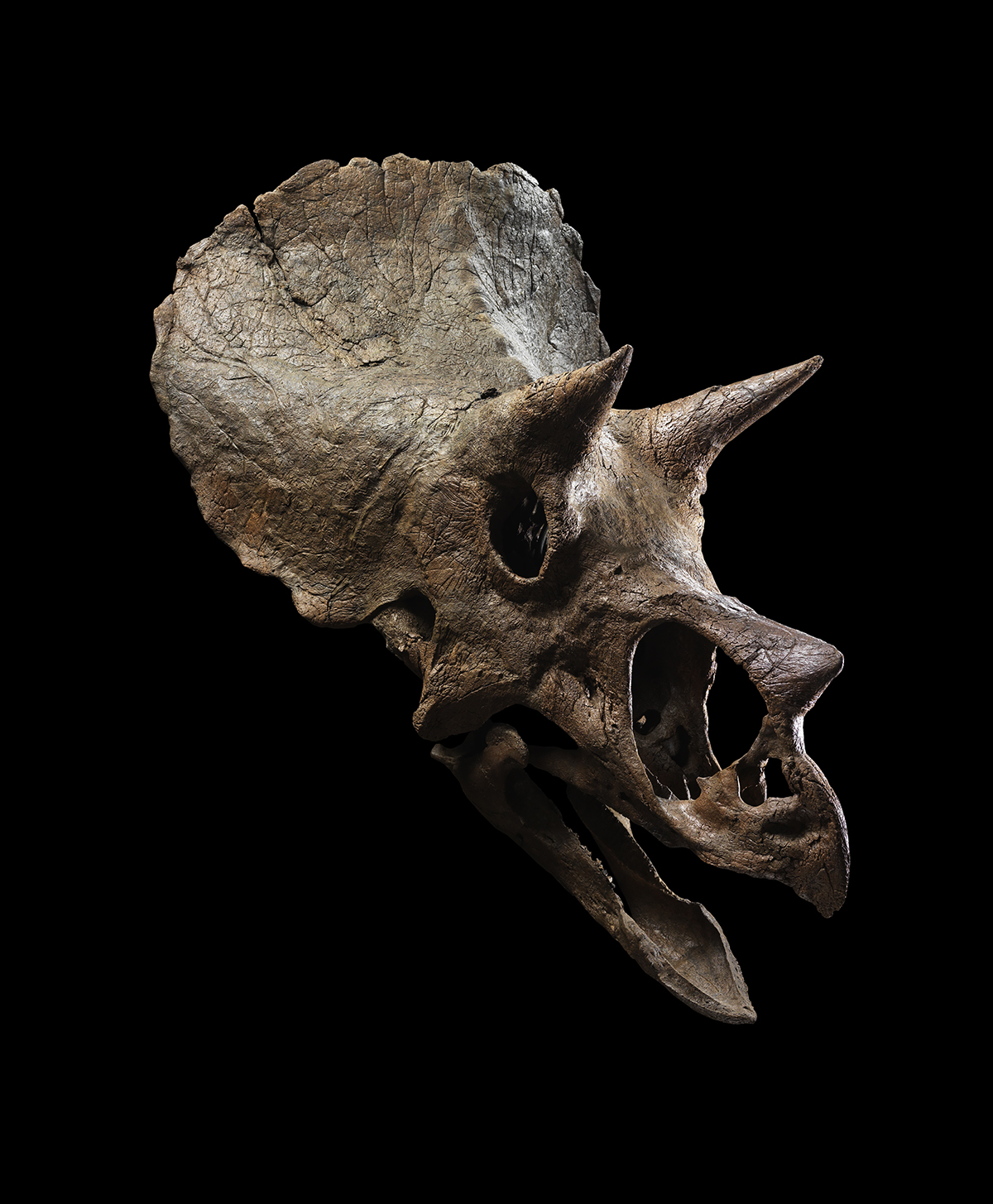
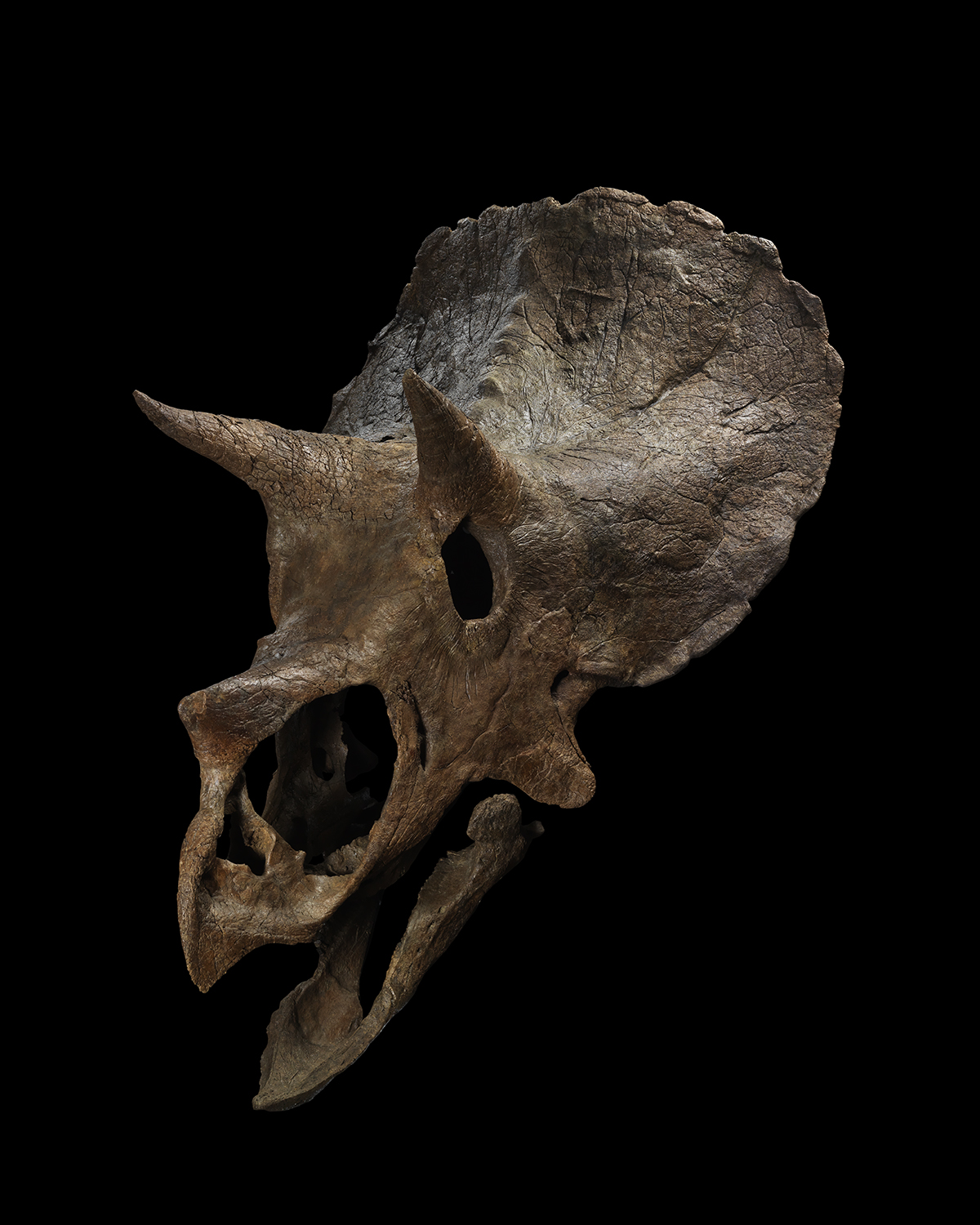
Dinosaurs, with their awe-inspiring scale and dramatic mass extinction, continue to capture the public imagination like few other subjects. They are both nostalgic and timeless, igniting a sense of wonder across generations. From popular culture to cutting-edge palaeontology, dinosaurs consistently draw global attention, both in science and the arts.
Among them, few are as instantly recognisable as the Triceratops. With its broad bony frill, parrot-like beak and three distinctive facial horns, it has become an icon of prehistoric life. The genus name means “three-horned face”, and the creature’s appearance is both formidable and strangely endearing.
The first known remains of a Triceratops were discovered in 1887 in Colorado. Initially believed to belong to a species of extinct bison, the fossilised horns were re-identified by American palaeontologist Othniel Charles Marsh, who formally described Triceratops horridus in 1889 and Triceratops prorsus in 1890. A fully mounted skeleton, named Hatcher, the first to go on display, was later unveiled by the Smithsonian Institution in 1905 and remains one of the centrepieces of their dinosaur collection.

Hatcher, the first mounted and exhibited Triceratops, went on display in 1905, Smithsonian Institution.
At our gallery on Berkeley Square, we are privileged to host a real Triceratops skull; an extraordinary specimen named Maple. Estimated to be from a sub-adult, nearing full maturity, Maple’s skull measures a remarkable 181 cm from jaw to frill. It is believed that Triceratops reached full maturity around ten years of age, making juvenile and subadult fossils particularly scarce.
Maple was discovered in 2019 in the fossil-rich badlands of Montana and excavated throughout 2020. Following discovery, the skull underwent meticulous preparation, including expert conservation and reconstruction.
Palaeontologists assess age not only by size but also by the development of certain cranial features such as epoccipitals, small bony projections that line the top edge of the frill. These ridges, along with bone texture and suture fusion, help scientists estimate growth stages and age at death.
We were honoured to exhibit Cera, a smaller juvenile Triceratops, closer in size to the BBC's Triceratops Clover at Frieze Masters in 2022, which had these epoccipital bones still visible, where it received notable attention, including a feature in The Art Newspaper. The overwhelming public and media interest affirmed what we already knew- dinosaurs are as culturally relevant today as they were 66 million years ago.

'Cera', A smaller example of a 'Juvenile Triceratops Skull' on show at Frieze Masters, London, in 2022. David Aaron Ltd
Triceratops is known for having had one of the largest skulls of any land animal in history. "It took up about a quarter of its whole body length, which is an unbelievably big skull," notes Dr Paul Barrett, palaeontologist at the Natural History Museum.
Today, fragments of Triceratops fossils are housed in museums and private collections around the world. However, few offer the opportunity to come face-to-face with a skull as complete and striking as Maple’s.
If you are in Mayfair, we welcome you to visit our gallery and experience this extraordinary piece of natural history in person. Maple is waiting.


Maple, Sub-adult Triceratops Skull, Maastrichtian, Late Cretaceous Period (circa 68 million years ago), Fossilised Bone, Frill width: 119 cm, Length from top of frill to tip of jaw: 181cm, Horn length: 30 cm, Height on stand: 241 cm. David Aaron Ltd
TEFAF NY: A Successful Debut
Published 16/05/2025
Read time: 2min
Over the past week, we have been making our debut at TEFAF New York. As first-time exhibitors at this prestigious art fair, we have been very delighted with the reception. The historic Park Avenue Armory provided an excellent setting for the carefully curated group of antiquities we selected for the fair.
Our exhibition began successfully with the sale of the 'Hultmark Horus', an exceptional Egyptian bronze falcon. The piece attracted significant attention from art collectors and the media prior to opening day. This interest resulted in its sale for £520,000 during the collector's preview. The hollow-cast bronze falcon served as a votive offering and possibly a ceremonial object during 663-525 B.C. in ancient Egypt. It was previously in the Private collection of Swedish collector Dr. Emil Hultmark (1872-1943), and the piece was photographed in his home in 1942.
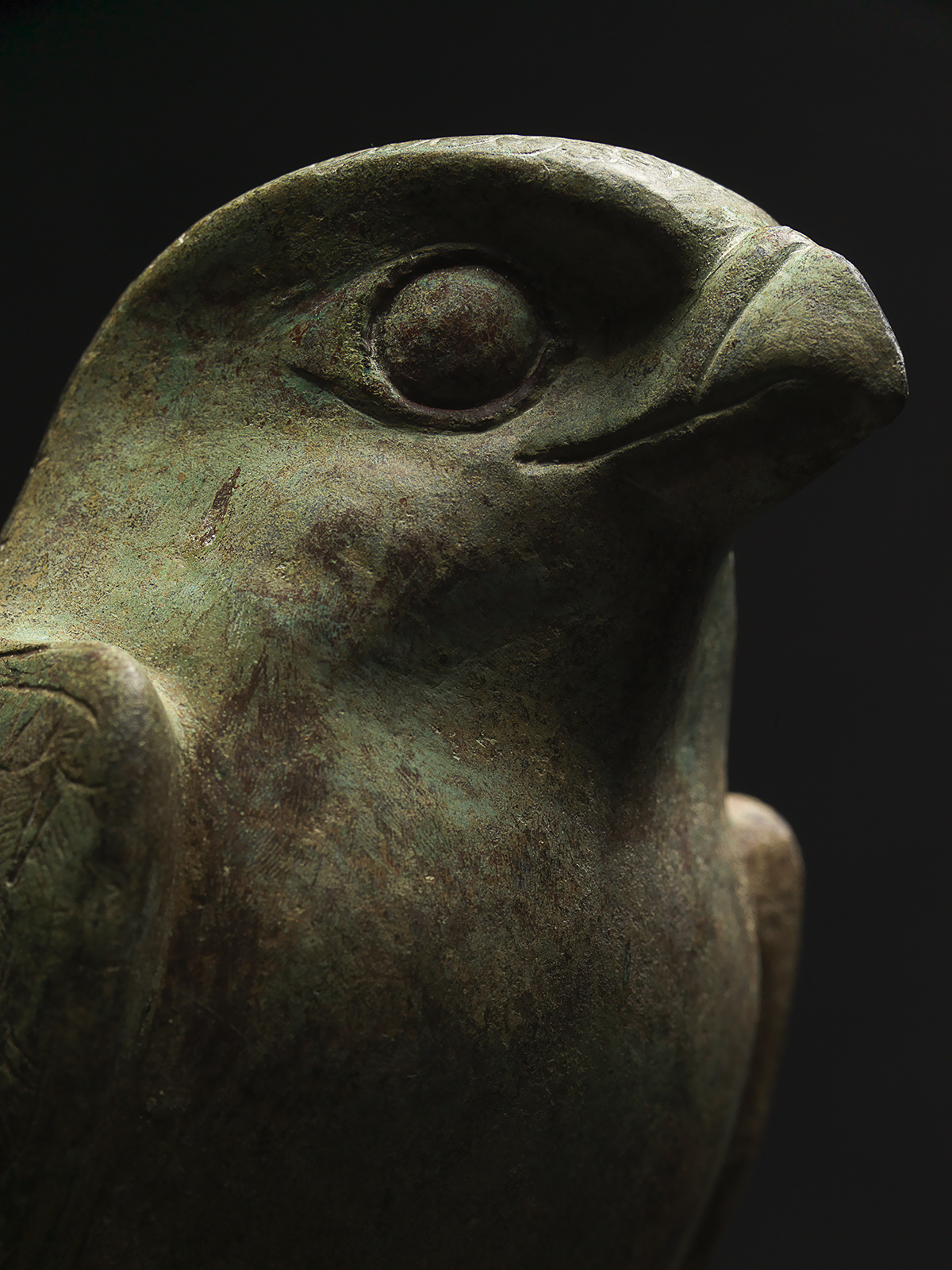
The Hultmark Horus, 663-525 B.C., Saitic Period, Egypt, Bronze, H: 22.7 cm. David Aaron Ltd
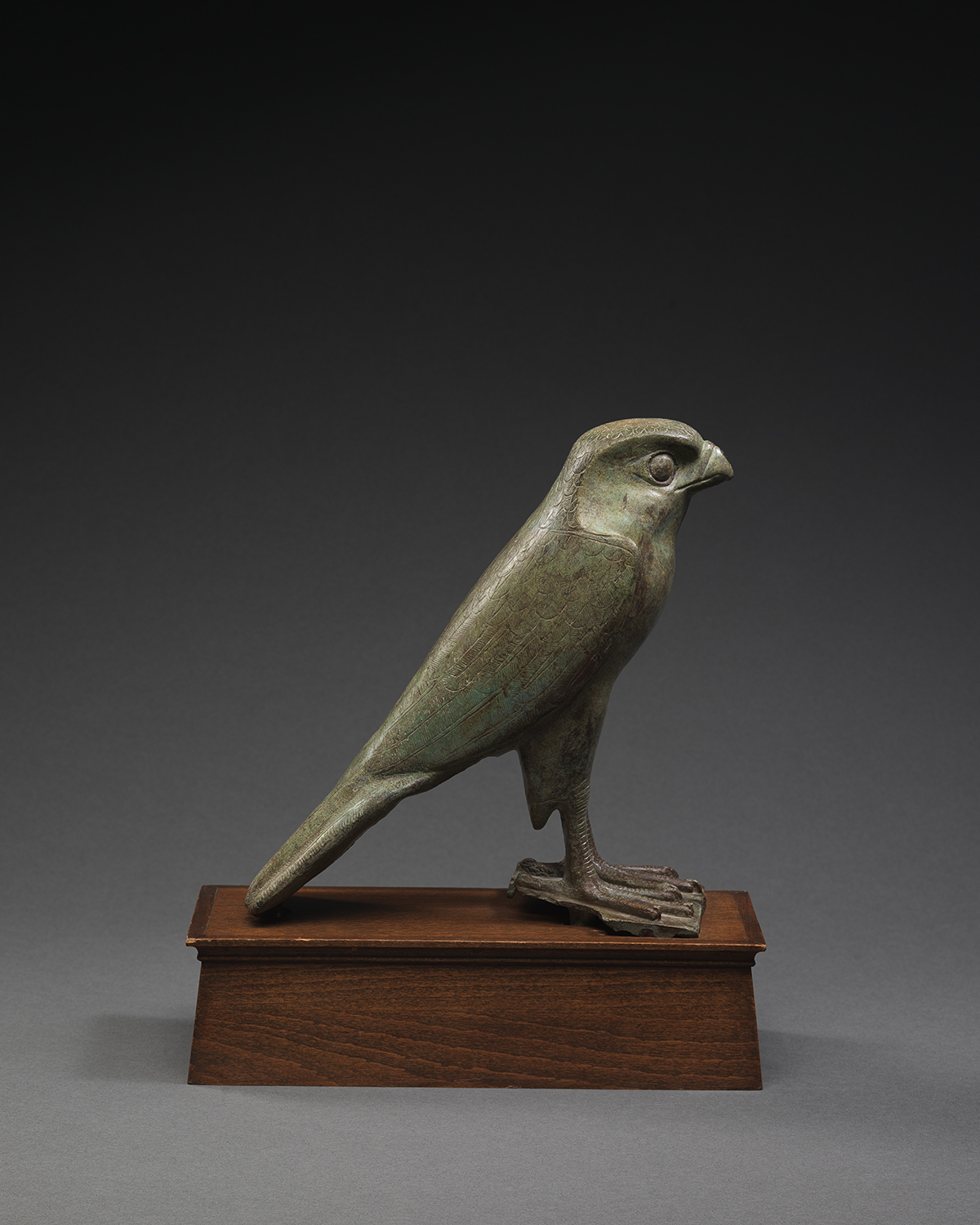
The Hultmark Horus, 663-525 B.C., Saitic Period, Egypt, Bronze, H: 22.7 cm. David Aaron Ltd
It was a particularly rewarding experience for us to bring such an important example of ancient Egyptian culture to New York "Being part of TEFAF's elite roster of exhibitors has been an amazing experience," noted Director Salomon Aaron. "The response to our collection has exceeded our expectations, and we appreciate the warm welcome from the New York art community."
We would like to thank the TEFAF organising committee for hosting another fantastic art show; Jitske Nap for the excellent photographs; the vetting committee for their professionalism; the stand-builders and shipping agents; the press team for coordinating our media interactions; and all the TEFAF staff who worked throughout the week and contributed to the quality of the experience.
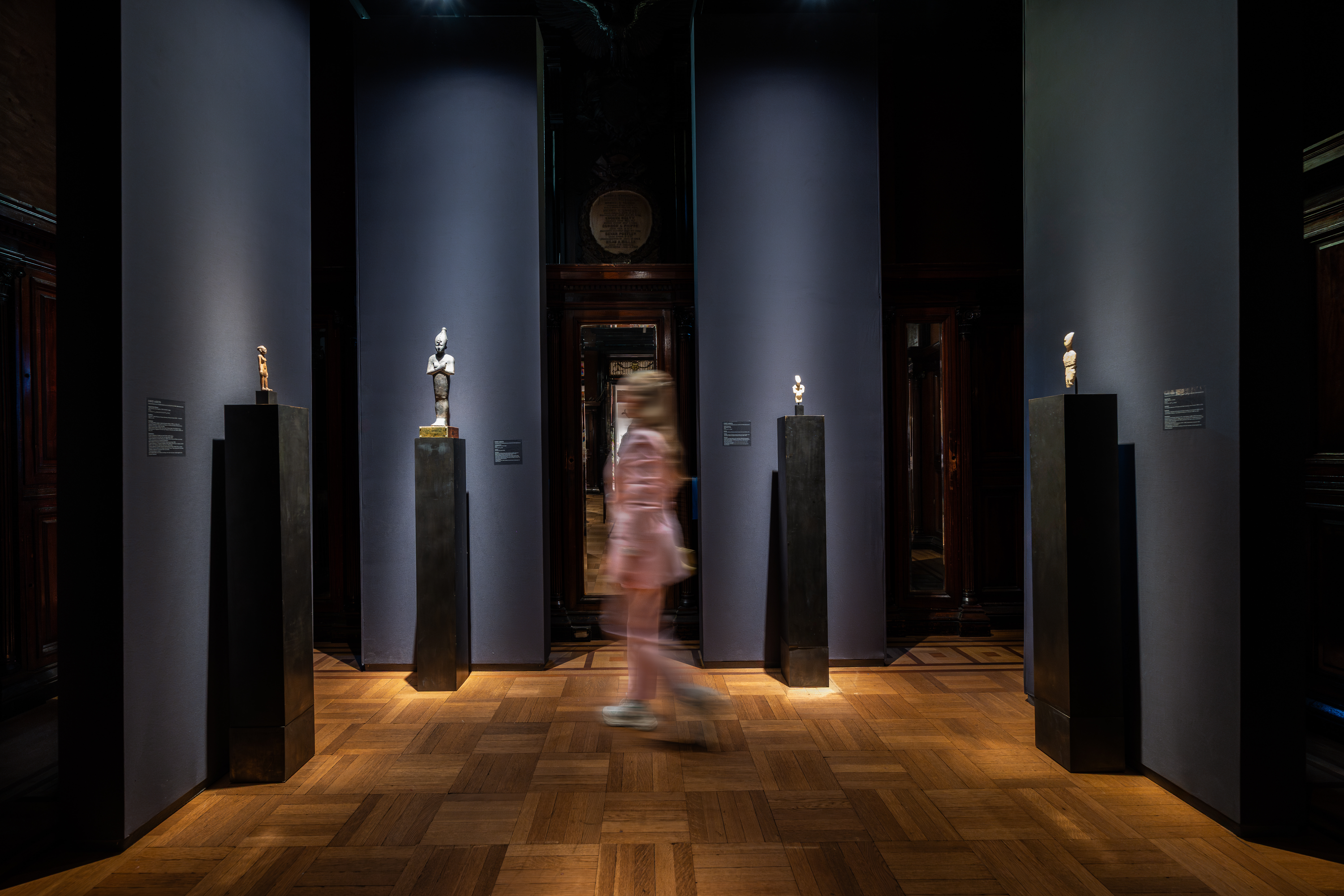

David Aaron, Stand 212, TEFAF NY, 2025. David Aaron Ltd
Our exhibition began successfully with the sale of the 'Hultmark Horus', an exceptional Egyptian bronze falcon. The piece attracted significant attention from art collectors and the media prior to opening day. This interest resulted in its sale for £520,000 during the collector's preview. The hollow-cast bronze falcon served as a votive offering and possibly a ceremonial object during 663-525 B.C. in ancient Egypt. It was previously in the Private collection of Swedish collector Dr. Emil Hultmark (1872-1943), and the piece was photographed in his home in 1942.

The Hultmark Horus, 663-525 B.C., Saitic Period, Egypt, Bronze, H: 22.7 cm. David Aaron Ltd

The Hultmark Horus, 663-525 B.C., Saitic Period, Egypt, Bronze, H: 22.7 cm. David Aaron Ltd
It was a particularly rewarding experience for us to bring such an important example of ancient Egyptian culture to New York "Being part of TEFAF's elite roster of exhibitors has been an amazing experience," noted Director Salomon Aaron. "The response to our collection has exceeded our expectations, and we appreciate the warm welcome from the New York art community."
We would like to thank the TEFAF organising committee for hosting another fantastic art show; Jitske Nap for the excellent photographs; the vetting committee for their professionalism; the stand-builders and shipping agents; the press team for coordinating our media interactions; and all the TEFAF staff who worked throughout the week and contributed to the quality of the experience.


David Aaron, Stand 212, TEFAF NY, 2025. David Aaron Ltd
The Artist as Collector: Jacob Epstein
Published 08/05/2025
Read time: 5min
Sir Jacob Epstein was born on New York’s Lower East Side in 1880, the third son to Polish Jewish immigrant parents. He developed an interest in drawing due to long periods of illness caused by pleurisy in his childhood. He began studying at the Arts Students’ League from the age of thirteen. At first, Epstein made his living by working in a bronze foundry, but he continued to take evening classes in sculpting. His first major commission was to illustrate Hutchins Hapgood’s 1902 book The Spirit of The Ghetto, and he used his earnings from this to move to Paris that same year.
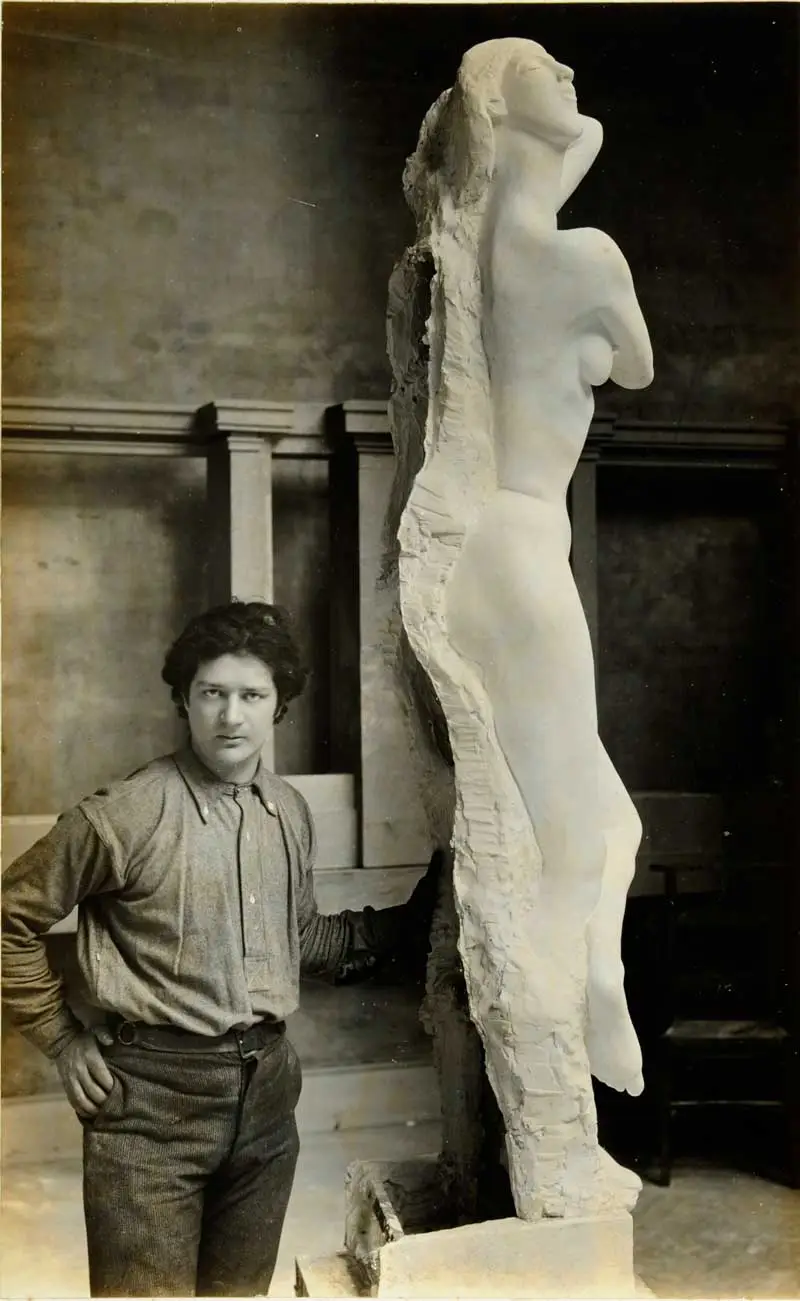
Jacob Epstein at work on one of the statues for the British Medical Association building, The Sketch (8 July 1908)
In Paris, Epstein studied sculpture at the Académie Julian and the École des Beaux-Arts; though his studies ended prematurely at the latter after his studio was destroyed as punishment for his refusal to perform menial tasks for the entrants in the Prix de Rome Concours. He visited the Louvre and saw artworks from outside the Western canon that were less known in Europe at that time, including early Greek work, Cycladic sculpture, the Lady of Elche bust, and the limestone bust of Akhenaten. At the Trocadéro and the Musée Cernusci, he observed what was then known as ‘primitive’ sculpture and Chinese art. In 1905, Epstein moved to London, where he would live for most of the rest of his life – he married Margaret Dunlop in 1906, and took British citizenship in 1911. Epstein spent a great deal of time in the British Museum, studying the Elgin Marbles and other Greek, Egyptian, African, and Polynesian sculptures, and used his observations to develop his own sculptural technique.
In 1907-8, Epstein was invited by architect Charles Holden to carve eighteen over-life-size figures for the façade of the British Medical Association’s new headquarters in The Strand. For this work, Epstein drew from the ancient and ‘primitive’ works he had studied, and suggested a series of nudes, ‘to express in sculpture the great primal facts of men and women’. According to his 1940 autobiography, Let There Be Sculpture, Epstein was taken completely by surprise at the level of vitriol and controversy sparked by this commission. Though many known figures and artists defended his pieces, public outcry made Epstein a household name and was to follow him throughout his career. For instance, the tomb he carved with Eric Gill for Oscar Wilde in Paris in 1911-12 and his 1915 Rock Drill sculpture prompted similar responses. One critic described Epstein as ‘a sculptor in revolt, who is in deadly conflict with the ideas of current sculpture’. His contemporary Henry Moore praised Epstein for unflinchingly bearing the weight of prejudice and hostility to forge a path for those sculptors who followed him, and expressed great gratitude for Epstein’s courage.
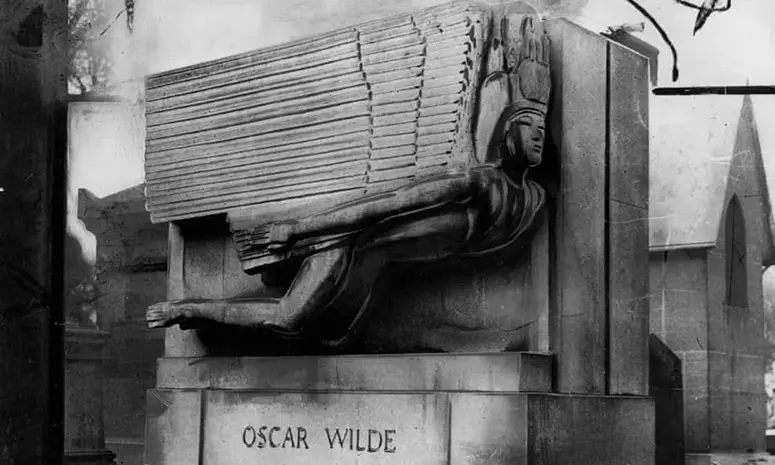
Oscar Wilde's tomb, located in Père Lachaise Cemetery, Paris.
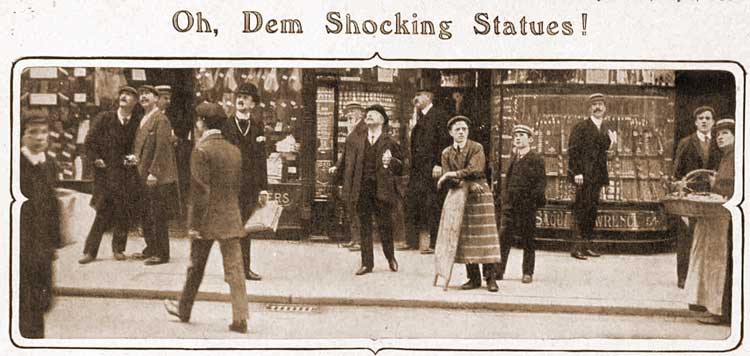
‘Pedestrians on the Strand eagerly gazing up at the building of the British Medical Association, in search of the statues which the papers said were rather shocking and ought to be suppressed.’ From The Bystander (1st July, 1908).
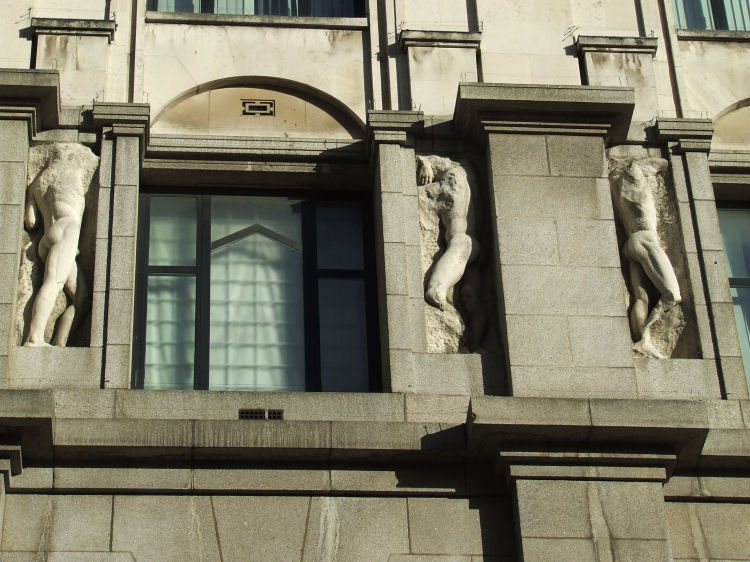
Three nude male figures from the Ages of Man series, former British Medical Association building, now Zimbabwe House, The Strand, London.
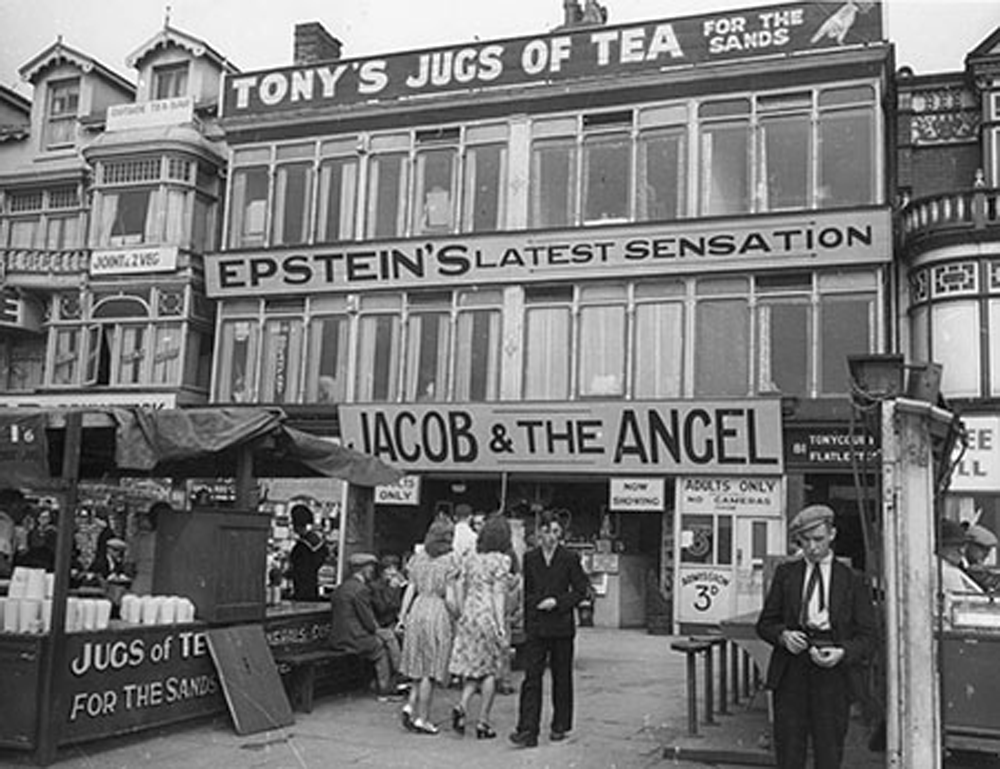
Signs advertising Epstein’s Jacob and the Angel (1940-1) at Louis Tussaud’s Waxworks, Blackpool

'Jacob Epstein Collector', front cover showing the interior of Epstein's home and some of his collection of African art. Published by Associazione Poro (Milan, Italy, 1989)
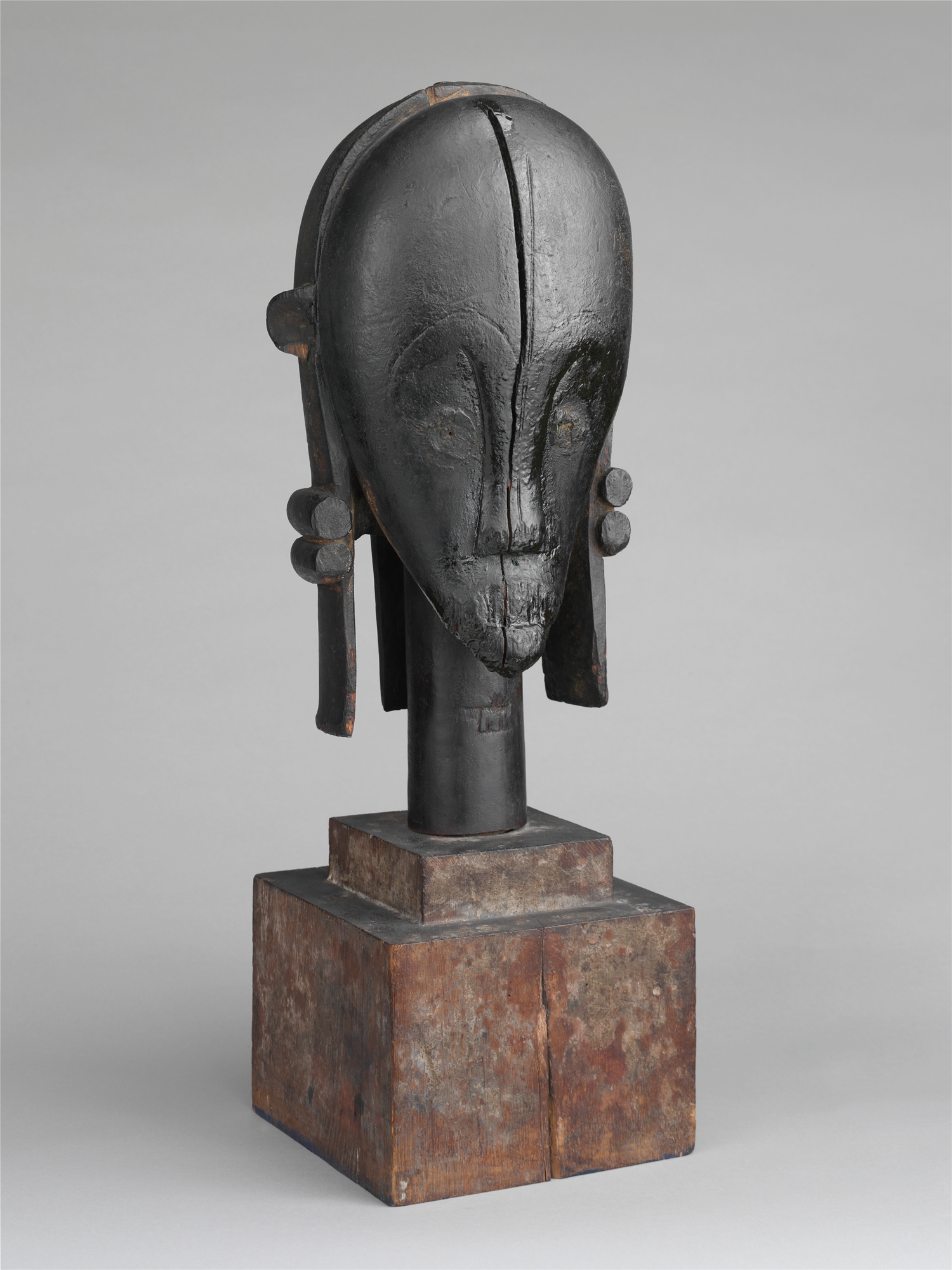
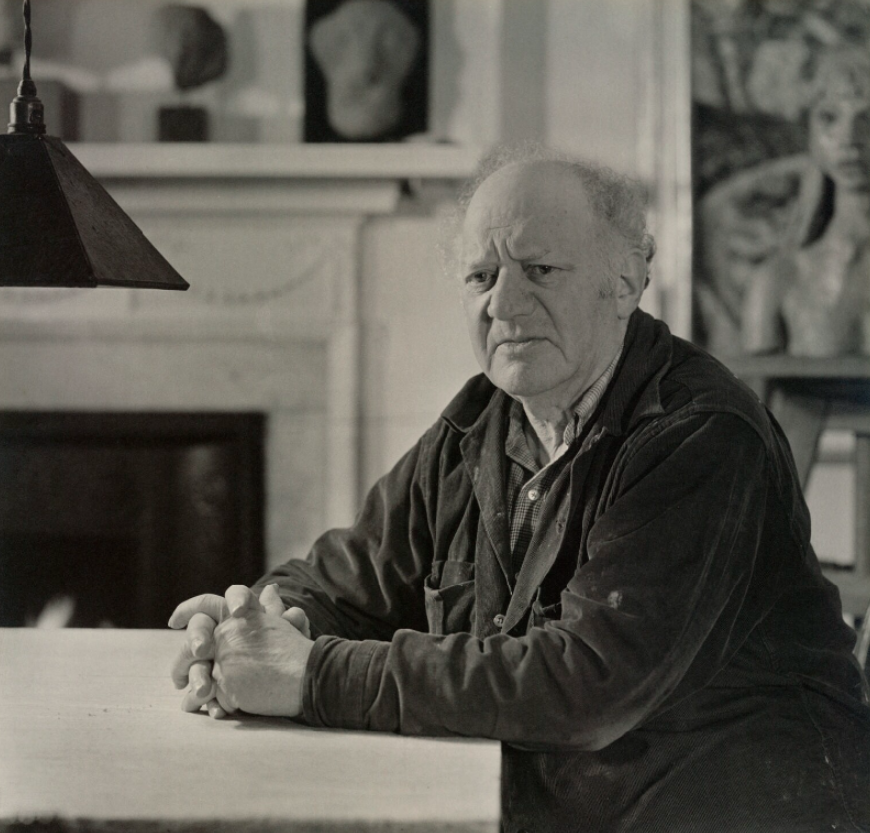
Portrait of Jacob Epstein, Geoffrey Ireland. Ancient Egyptian items from Epstein’s collection can be seen on the mantlepiece behind him. National Portrait Gallery.
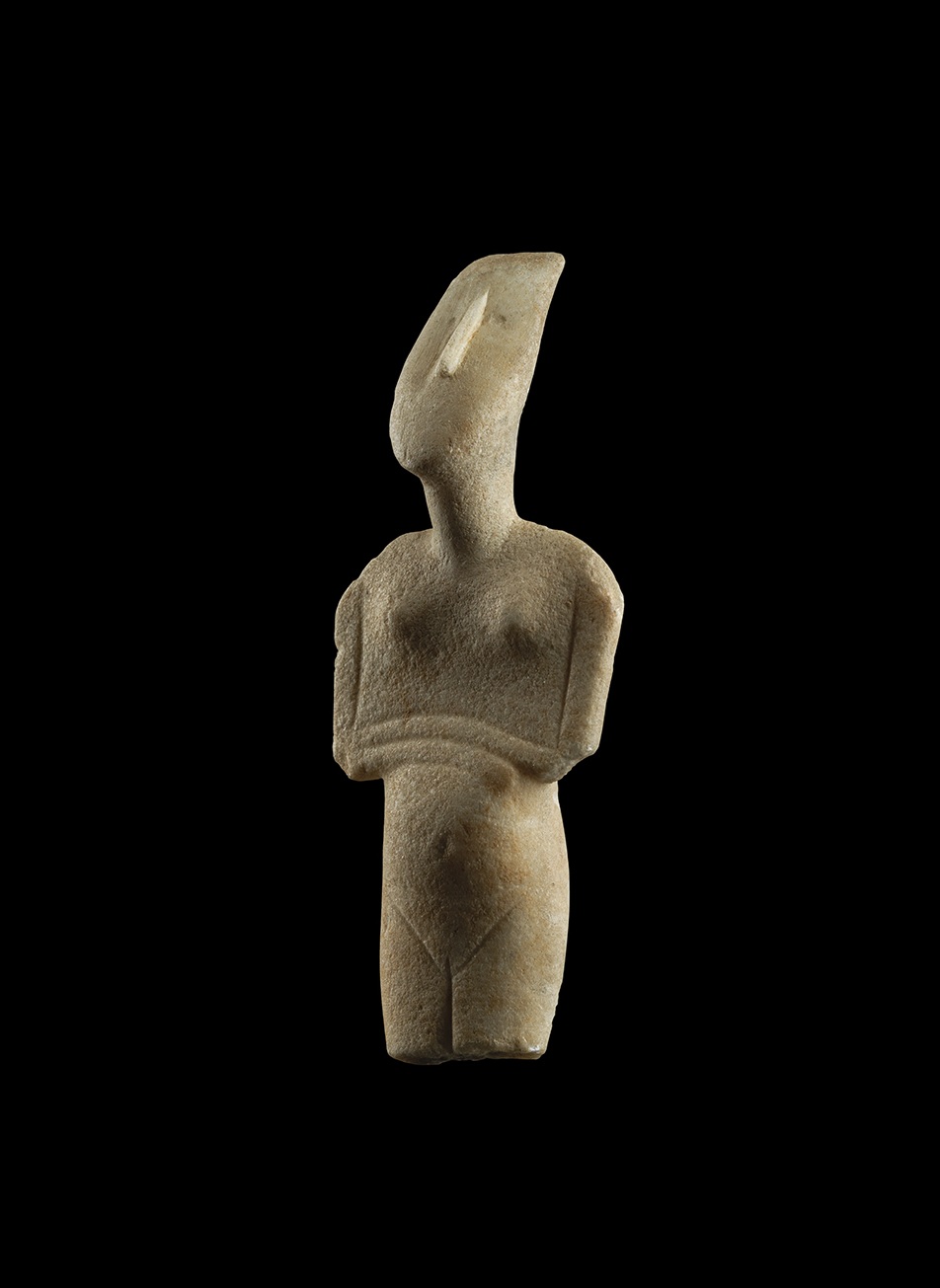
Pregnant Cycladic Idol, 2500-2000 B.C., Greece, Marble, H: 14.5 cm, previously in the Private Collection of Sir Jacob Epstein. David Aaron Ltd

In the 1939 exhibition catalogue, Epstein showcased multiple works, including busts of children and the sculpture of 'ADAM'.

The monumental sculpture of 'ADAM' was later on show in Blackpool. The exhibition received mixed reviews, and a Pathé newsreel shows crowds attending, including a woman fainting.
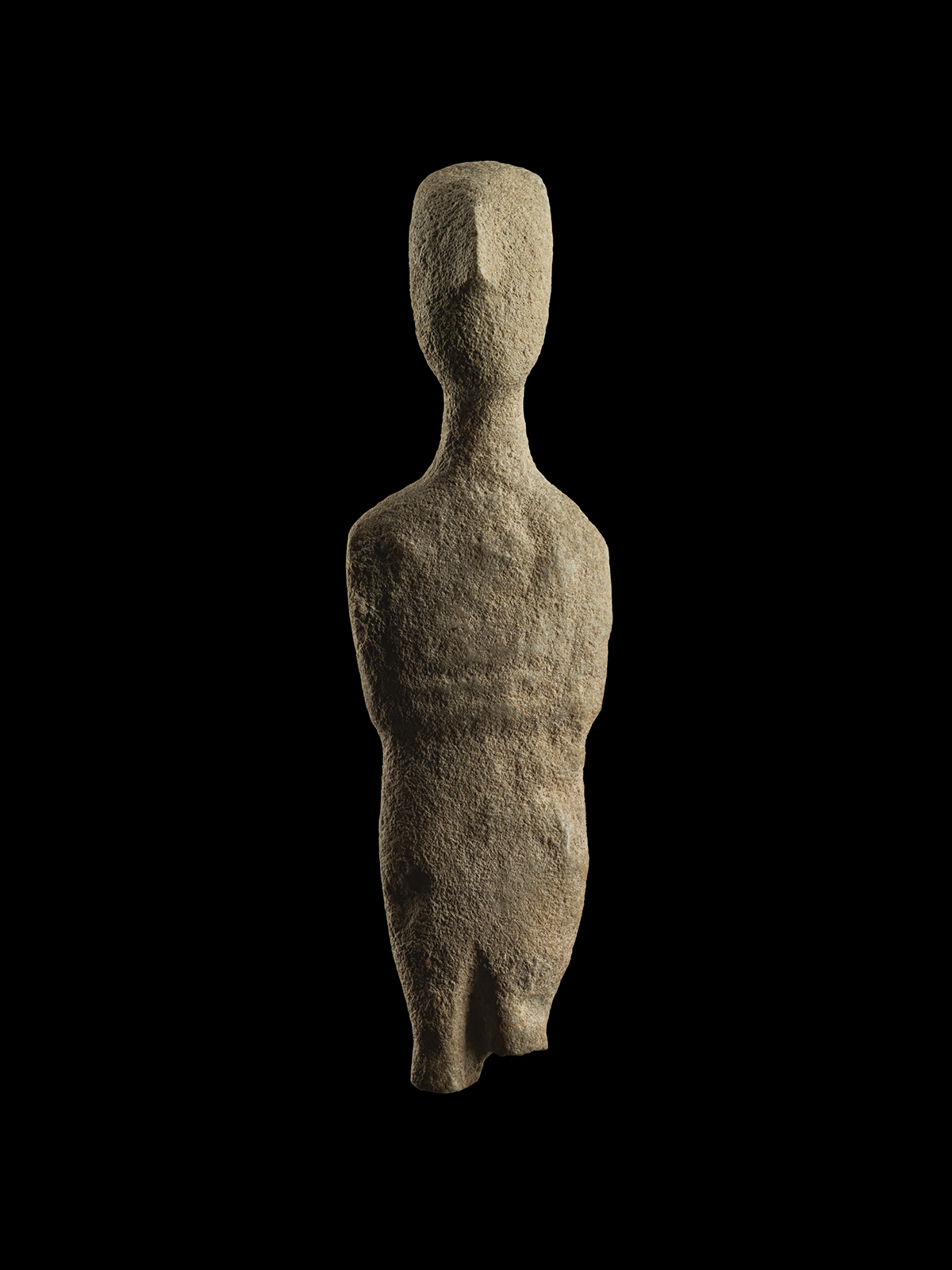
Cycladic Idol, 2500-2000 B.C., Greece, Marble, H: 21.4 cm, previously in the Private Collection of Sir Jacob Epstein. David Aaron Ltd.

Jacob Epstein at work on one of the statues for the British Medical Association building, The Sketch (8 July 1908)
In Paris, Epstein studied sculpture at the Académie Julian and the École des Beaux-Arts; though his studies ended prematurely at the latter after his studio was destroyed as punishment for his refusal to perform menial tasks for the entrants in the Prix de Rome Concours. He visited the Louvre and saw artworks from outside the Western canon that were less known in Europe at that time, including early Greek work, Cycladic sculpture, the Lady of Elche bust, and the limestone bust of Akhenaten. At the Trocadéro and the Musée Cernusci, he observed what was then known as ‘primitive’ sculpture and Chinese art. In 1905, Epstein moved to London, where he would live for most of the rest of his life – he married Margaret Dunlop in 1906, and took British citizenship in 1911. Epstein spent a great deal of time in the British Museum, studying the Elgin Marbles and other Greek, Egyptian, African, and Polynesian sculptures, and used his observations to develop his own sculptural technique.
In 1907-8, Epstein was invited by architect Charles Holden to carve eighteen over-life-size figures for the façade of the British Medical Association’s new headquarters in The Strand. For this work, Epstein drew from the ancient and ‘primitive’ works he had studied, and suggested a series of nudes, ‘to express in sculpture the great primal facts of men and women’. According to his 1940 autobiography, Let There Be Sculpture, Epstein was taken completely by surprise at the level of vitriol and controversy sparked by this commission. Though many known figures and artists defended his pieces, public outcry made Epstein a household name and was to follow him throughout his career. For instance, the tomb he carved with Eric Gill for Oscar Wilde in Paris in 1911-12 and his 1915 Rock Drill sculpture prompted similar responses. One critic described Epstein as ‘a sculptor in revolt, who is in deadly conflict with the ideas of current sculpture’. His contemporary Henry Moore praised Epstein for unflinchingly bearing the weight of prejudice and hostility to forge a path for those sculptors who followed him, and expressed great gratitude for Epstein’s courage.

Oscar Wilde's tomb, located in Père Lachaise Cemetery, Paris.

‘Pedestrians on the Strand eagerly gazing up at the building of the British Medical Association, in search of the statues which the papers said were rather shocking and ought to be suppressed.’ From The Bystander (1st July, 1908).

Three nude male figures from the Ages of Man series, former British Medical Association building, now Zimbabwe House, The Strand, London.
After the First World War, Epstein received relatively few commissions, although his notoriety continued. Between the 1930s and mid-1950s, some of Epstein’s sculptures were exhibited within the anatomical curiosity section of Louis Tussaud’s waxworks, alongside diseased body parts and conjoined twin babies preserved in jars. Epstein’s bronze portraits were received more favourably; these depicted a range of figures, from his mistress and later wife Kathleen Garman, to Albert Einstein, to ragamuffin children. In the 1950s, Epstein received some important public commissions, including the statue of Jan Smuts in Parliament Square. Epstein was appointed a Knight Commander of the Order of the British Empire in the 1954 New Year Honours. In 1958, Epstein was confined to hospital due to illness, but continued to work even up to the day of his death in 1959.

Signs advertising Epstein’s Jacob and the Angel (1940-1) at Louis Tussaud’s Waxworks, Blackpool

'Jacob Epstein Collector', front cover showing the interior of Epstein's home and some of his collection of African art. Published by Associazione Poro (Milan, Italy, 1989)

Sculptural Bust from a Reliquary Ensemble (The Great Bieri), 19th century, Wood and copper alloy, H46.5cm. Previously in the private collection of Jacob Epstein, now with the Metropolitan Museum, NY, USA.
Epstein dated the start of his collection of African sculpture to around 1905 – the same time that Picasso, Vlaminck, and Matisse began to express their interest in such pieces, putting him at the forefront of Western interest in ‘primitive’ art. The dealer Paul Guillaume, writing in 1917, described Epstein as ‘le promoteur’ of African art in England. In 1924, Henry Moore visited Epstein’s house in Hyde Park Gate, and remarked that his bedroom ‘was so overflowing with negro sculpture etc., that I wondered how he got into bed without knocking something over’. By the time Arnold Haskell interviewed the artist in 1931, Epstein had around 200 statues, masks, and ivories. Each week during his conversations with Haskell, Epstein would rearrange the room with different items from his collection. By Haskell’s account ‘This is certainly the finest private collection in England, and one of the finest in the world. Each piece is the work of some remarkable unknown artist, and there are few, very few, ‘mistakes’ amongst them … There is none of the deadness of the museum here, and the works have not lost their individuality.’[1] Epstein himself took great pride in his collection, asserting that his possessions were superior to or more authentic than others’.

Portrait of Jacob Epstein, Geoffrey Ireland. Ancient Egyptian items from Epstein’s collection can be seen on the mantlepiece behind him. National Portrait Gallery.

Pregnant Cycladic Idol, 2500-2000 B.C., Greece, Marble, H: 14.5 cm, previously in the Private Collection of Sir Jacob Epstein. David Aaron Ltd
Epstein collected with great voracity, often acquiring pieces before he had money in hand to pay for them (several of these debts were only paid off after his death). He eventually had over 1,000 pieces in his collection at Hyde Park Gate. Although Epstein’s name rarely appears in the price lists of auction houses like Sotheby’s, he is known to have purchased items through a range of avenues, including the London dealer John Hewett, and Galerie Apollinaire. He was persistent in chasing what he felt were quality pieces – for instance, he first enquired about the ‘Brummer Head’ while it was still in the possession of Joseph Brummer well before 1913, and eventually purchased it in 1935 when he discovered it in a dealer’s basement. Epstein also advised other collectors of African art, including Helena Rubinstein, whom he met in 1909.
Epstein professed that he was not interested in works for their ethnographical import, but for their artistic and formal qualities. He claimed he had two collections: one with the best works of art he could find on the market, and one he made for himself as an artist, of lesser works that gave him new ideas around formal issues. Epstein praised the ‘restraint in craftsmanship, delicacy and sensitiveness, [and] regard for the material’ he saw in ‘primitive’ sculpture.[1] Epstein’s own work, such as Female Figure in Flenite (1913) and Venus (1917), incorporated the simple yet evocative forms that he admired in non-Western figures.

In the 1939 exhibition catalogue, Epstein showcased multiple works, including busts of children and the sculpture of 'ADAM'.

The monumental sculpture of 'ADAM' was later on show in Blackpool. The exhibition received mixed reviews, and a Pathé newsreel shows crowds attending, including a woman fainting.
After Epstein’s death in 1959, the Arts Council held a memorial exhibition featuring most of the works from his collection. In 1963, Carlo Monzino bought the major part of the collection, in what he described as ‘the culminating moment for me’. Since then, works from Epstein’s collection have gone on to sell for record-breaking prices and are found in museums around the world. The British Museum has twelve objects from his collection, all purchased in the sale at Christie’s, 15 December 1961, while the Metropolitan Museum has nine, and others are with The Dapper Foundation, Paris.

Cycladic Idol, 2500-2000 B.C., Greece, Marble, H: 21.4 cm, previously in the Private Collection of Sir Jacob Epstein. David Aaron Ltd.
Corsican Bronzes: One-Way Track to the Past
Published 08/05/2025
Read time: 3min
This collection of bronze implements were discovered at the same site on the bed of the Gravona river in Corsica around 1888-1890. They were found during the construction of the Ajaccio-Bastia railway line, which first opened in 1888. This enables us to pinpoint their location to one of two possible sites where the railway crosses the river: either in Carbuccia, 10 km north-east of Ajaccio, or at Bocognano, 10 km further in the same direction along the valley.
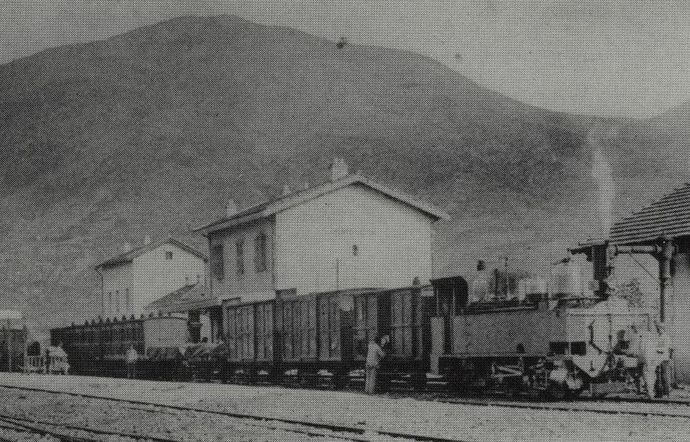
Connecting trains in Ponte-Leccia station. Mixed right for Ajaccio towed by a 031 Fives-Lille locomotive, circa 1882 (Collection J.RENAUD)
The group contains:
-one dagger
-one crescent-shaped bronze that may have been a belt-buckle
-one rounded pommel
-one disc with a projecting spike, which may have been part of a horses harness or brooch
-three bow fibulae (brooches) of various sizes
-three simple rings of differing sizes, possibly a form of proto-currency.
The style of these objects suggests a burial date of around 900 BCE. Then-director of the Musée préhistorique et gallo-romain in Strasbourg, Dr. Robert Forrer, published this group in an 8-page essay in the bulletin of the Société Préhistorique Française in 1924.
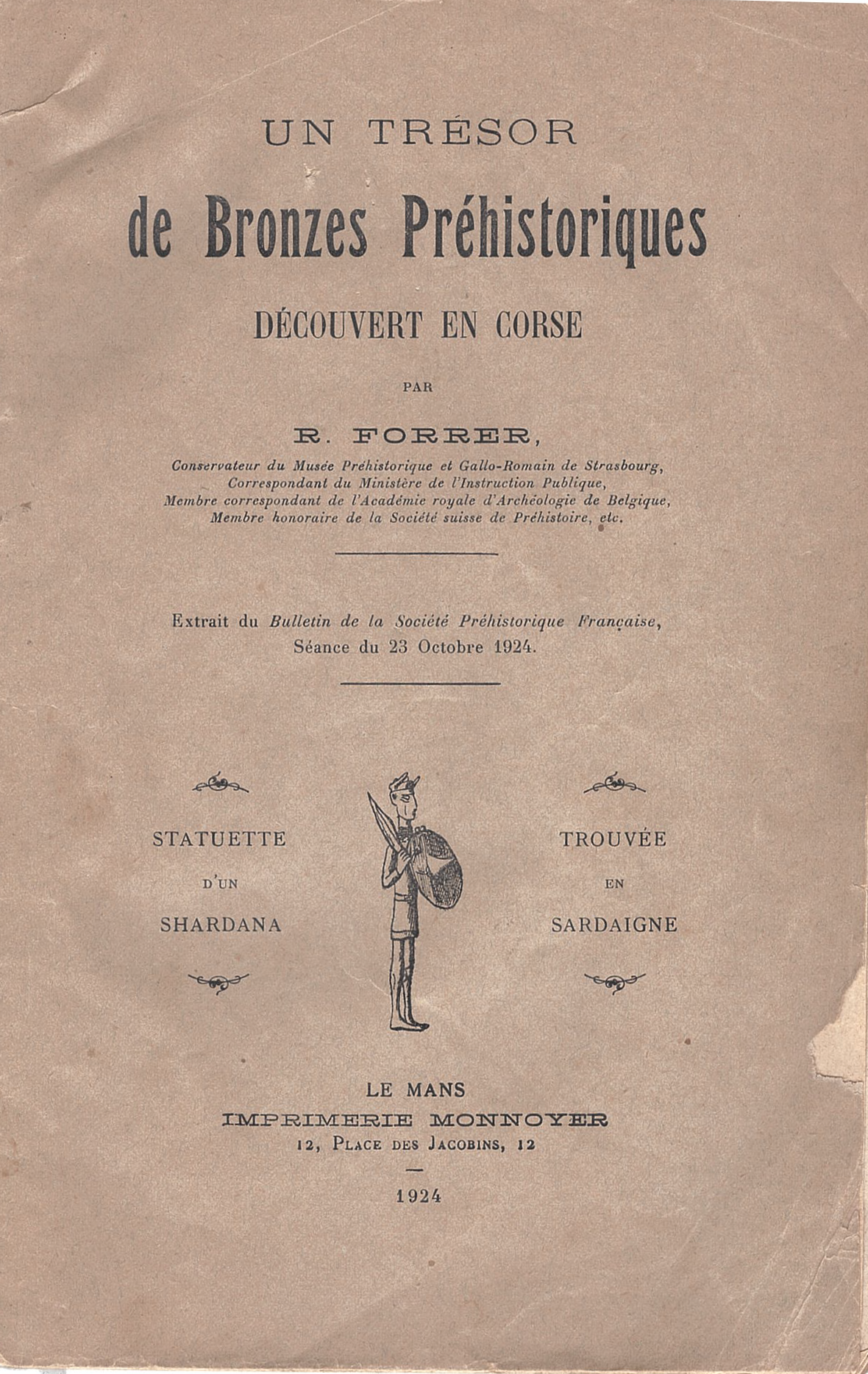
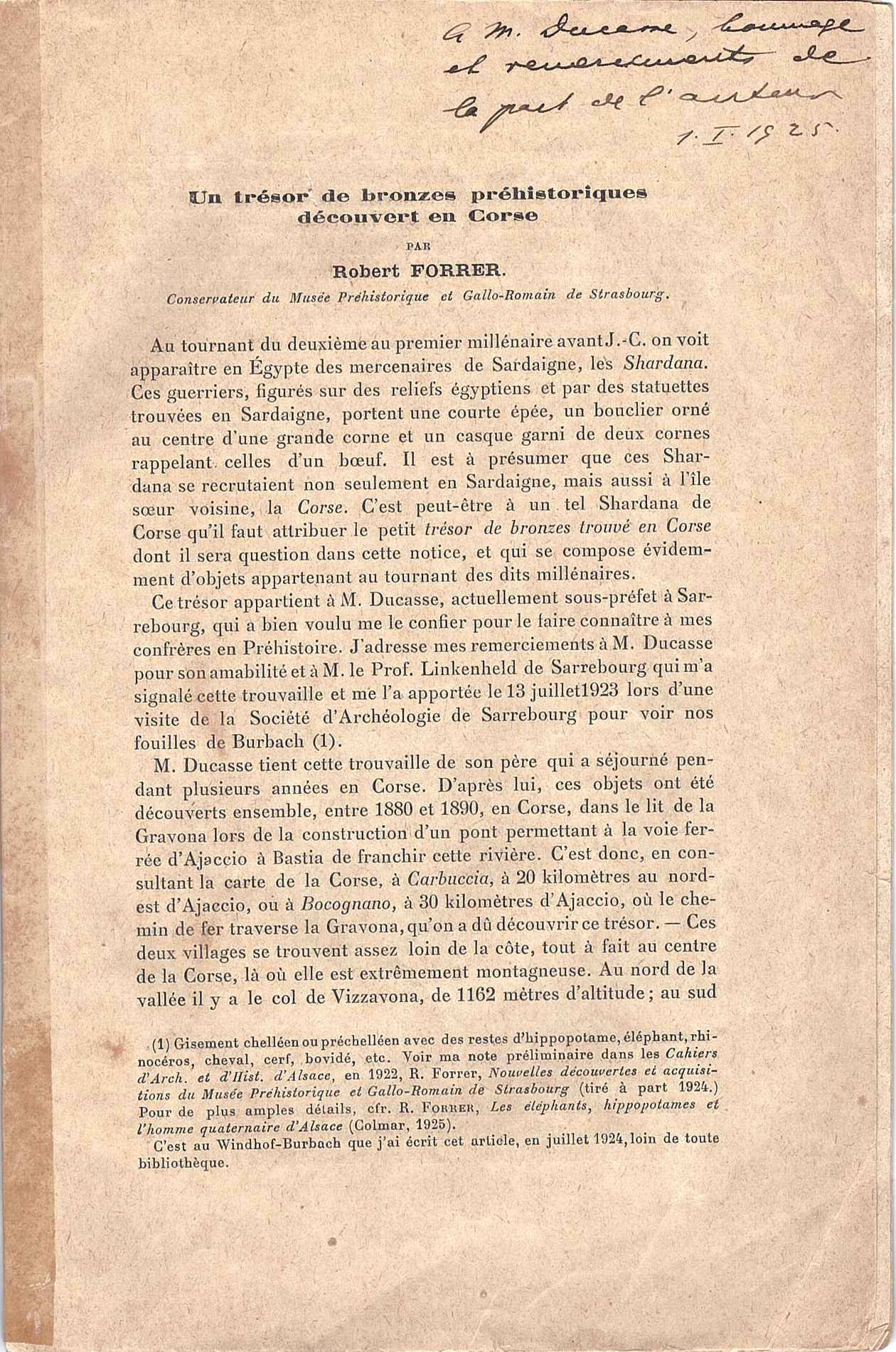
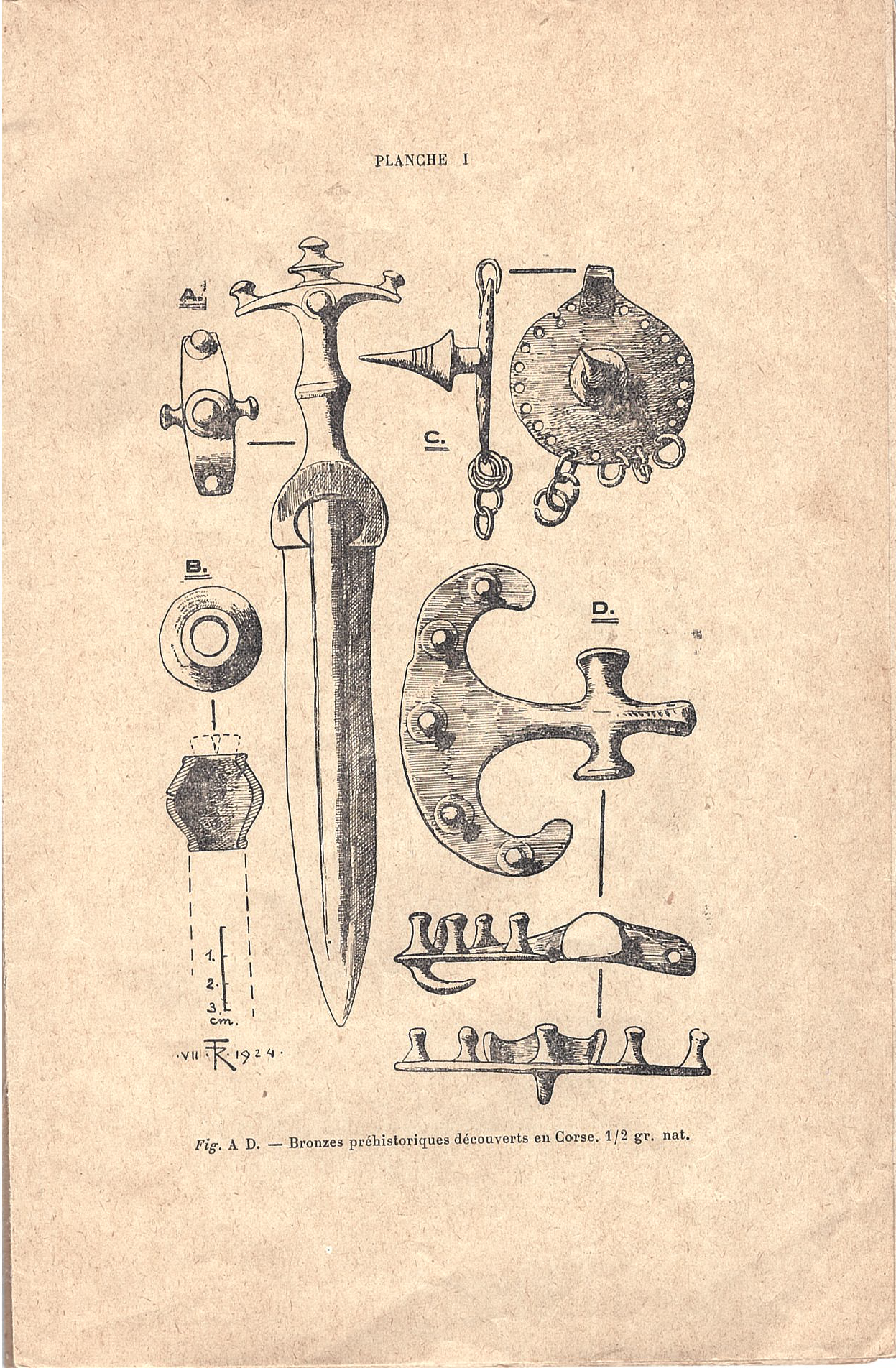
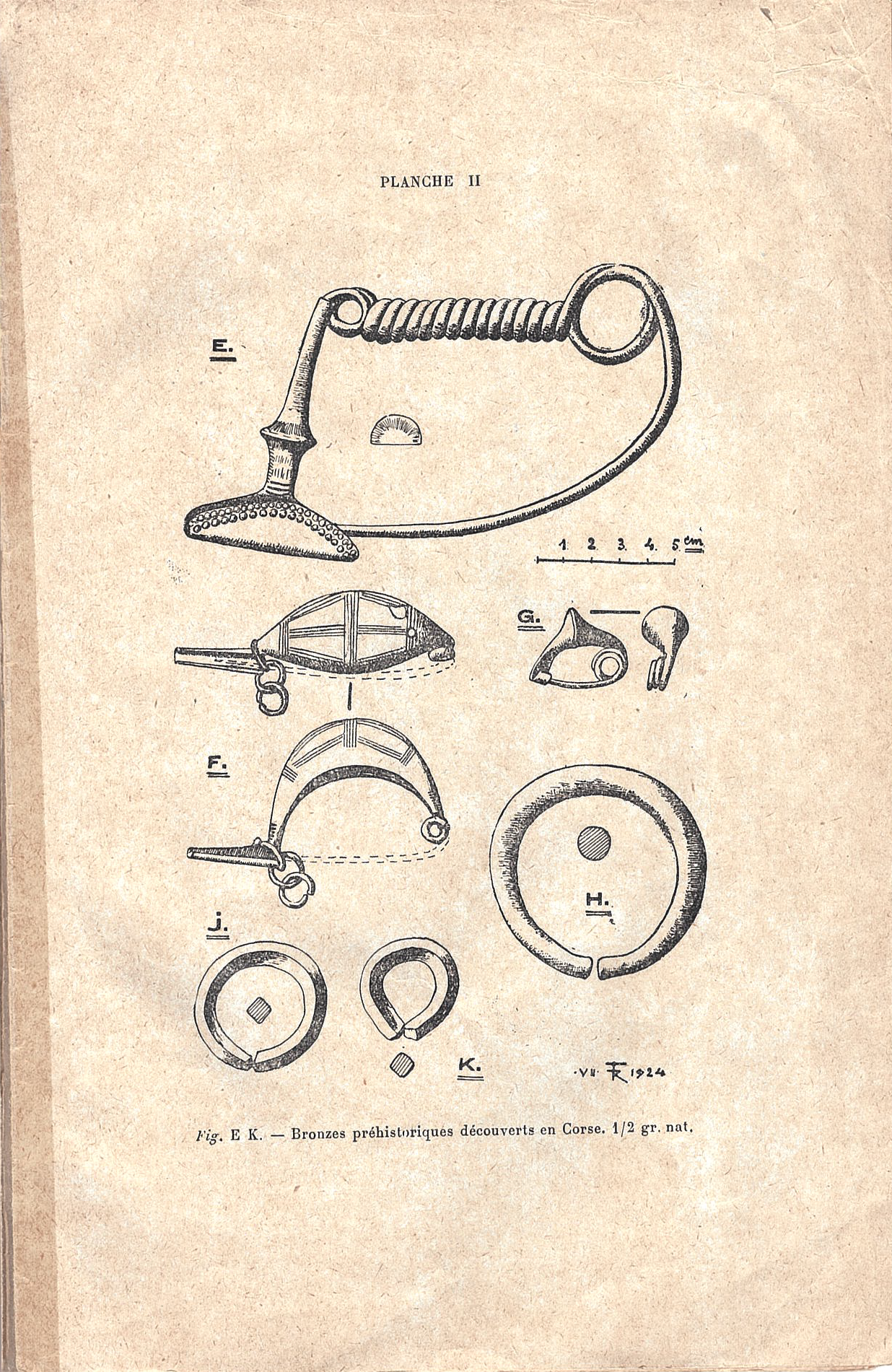
R Forrer, ‘Un trésor de bronzes préhistoriques decouvert en Corse’, Bulletin de la Société préhistorique de France, 10, 1924, pp. 224-232.
Why were these pieces buried together?
It is clear that these pieces were intentionally buried as a group by someone in ancient history. What is not clear is why. One theory is that they formed part of a funerary hoard, perhaps together with several other buried objects along the banks of the Gravona. Another is that they were a trader’s wares or a warrior’s treasure and were buried for safekeeping.
The two possible discovery sites along the river are both in inland mountainous regions. Forrer’s theory was that the bronzes were brought in from Sardinia, via Ajaccio and up the river, and were the property of a Sherden warrior. However, recent research indicates that the Torrean civilisation in the south of Corsica – previously thought to have begun in the second millennium B.C. when Sherden warriors landed on the island – was in fact an indigenous population. There is at least one confirmed example of the distinctive megalithic towers (torri) built by this civilisation in the Gravona valley, north-east of the capital. Therefore, these bronzes may have been produced near the discovery site.
What are they?
Some of the bronzes require no explanation, such as the dagger in typical late Bronze Age style, and the fibulae, which closely resemble similar brooches now in major museums.
Some of the pieces are, however, less easily understood. One is the crescent-shaped object adorned with five evenly-spaced raised round rivets, a short cross with rounded ends extends from the inner centre of the arc. The rivets and hook could have served as a means of affixing the bronze in place, suggesting that this object may have been a belt buckle, or perhaps part of a scabbard or horse harness.
Another is the circular disc, with a large, rounded spike projecting from its centre. This form resembles the shields held by warriors in Nuragic bronze statues, possibly linking the pieces to the Sardinian warriors from Forrer’s theory. Small holes are pierced around the circumference, four of which contain chain links, suggesting that this disc was previously part of a larger object. The disc may have been a phalera on a horse harness or perhaps the centrepiece of a brooch, as in a contemporaneous example in the Metropolitan Museum of Art, New York (2007.498.2).
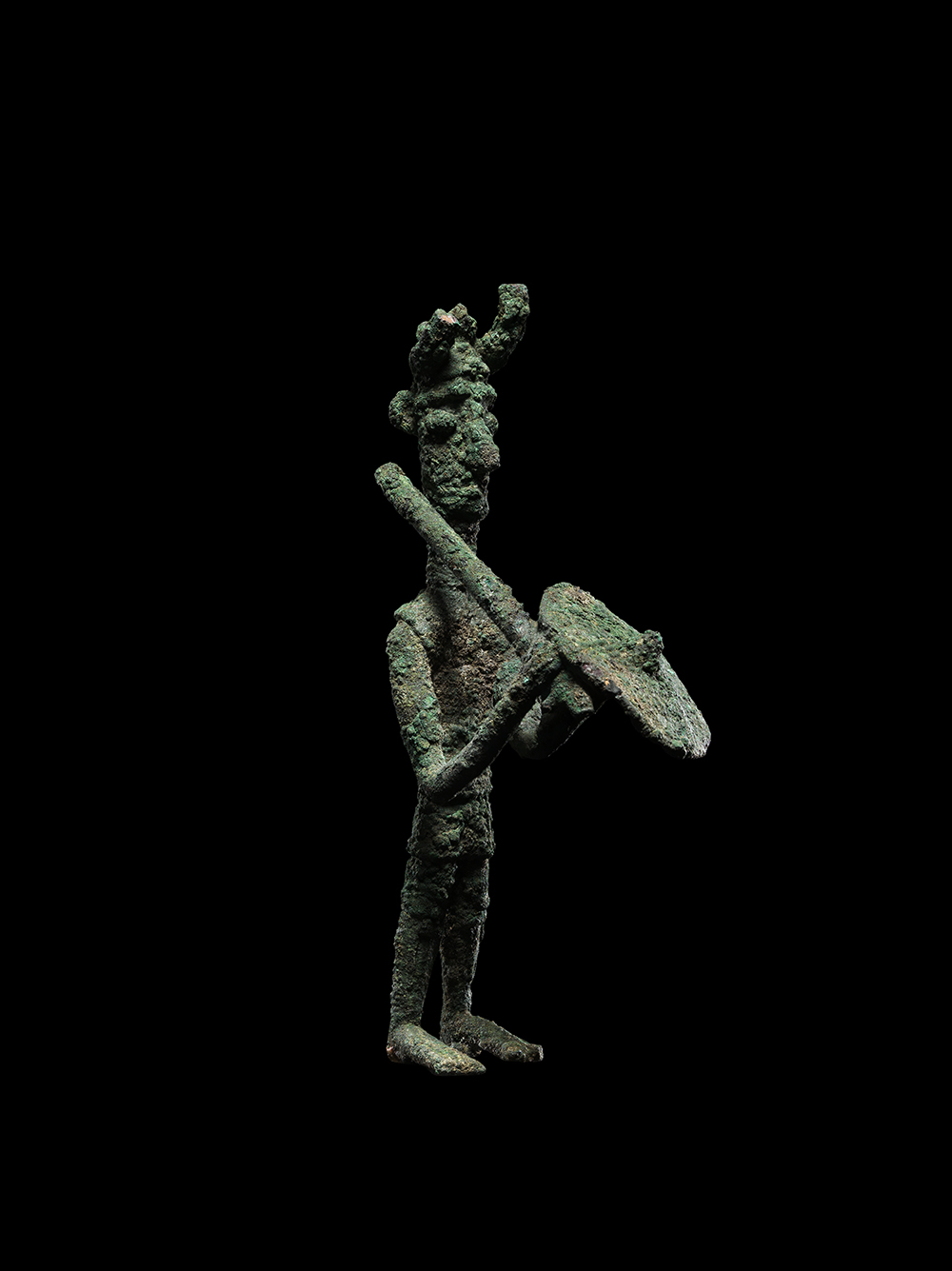
The small pommel in the form of a hollow ovoid has one hole running through its length and another smaller hold at the side. These would allow a stick to be inserted through the pommel and held in place by a small nail, so that the pommel could be wielded as a part of a sceptre or other weapon. As it weighs in at a very light 69 grams, however, it seems most likely that the pommel would have been purely decorative – an ancient warrior wouldn’t have been able to do much damage with a 3.7 cm bronze!
Most puzzling are the three rings, each formed from a single bronze rod bent into a circle. Although they resemble Bronze Age bracelets from other sites, the largest is only 7.7 cm in diameter, and the others are much smaller, at 4.8 cm and 3.7 cm. These smallest two, would definitely not fit over anyone’s wrist. Forrer suggested one possible explanation of their purpose. He argued that, due to their simple forms and the relationships between their weights (the weight of the smallest is about 2/3 of the second smallest, which is approximately 1/4 of the largest), these rings may have been a form of currency, of the kind found in other Bronze Age settlements in Europe.
The Corsican Hoard raises many questions about the ancient society that produced it. We can only speculate as to who owned the pieces and why they were buried, and what purpose the bronzes served. Perhaps they hold the key to unravelling the secrets of Bronze Age Corsica.

Connecting trains in Ponte-Leccia station. Mixed right for Ajaccio towed by a 031 Fives-Lille locomotive, circa 1882 (Collection J.RENAUD)
The group contains:
-one dagger
-one crescent-shaped bronze that may have been a belt-buckle
-one rounded pommel
-one disc with a projecting spike, which may have been part of a horses harness or brooch
-three bow fibulae (brooches) of various sizes
-three simple rings of differing sizes, possibly a form of proto-currency.
The style of these objects suggests a burial date of around 900 BCE. Then-director of the Musée préhistorique et gallo-romain in Strasbourg, Dr. Robert Forrer, published this group in an 8-page essay in the bulletin of the Société Préhistorique Française in 1924.




R Forrer, ‘Un trésor de bronzes préhistoriques decouvert en Corse’, Bulletin de la Société préhistorique de France, 10, 1924, pp. 224-232.
Why were these pieces buried together?
It is clear that these pieces were intentionally buried as a group by someone in ancient history. What is not clear is why. One theory is that they formed part of a funerary hoard, perhaps together with several other buried objects along the banks of the Gravona. Another is that they were a trader’s wares or a warrior’s treasure and were buried for safekeeping.
The two possible discovery sites along the river are both in inland mountainous regions. Forrer’s theory was that the bronzes were brought in from Sardinia, via Ajaccio and up the river, and were the property of a Sherden warrior. However, recent research indicates that the Torrean civilisation in the south of Corsica – previously thought to have begun in the second millennium B.C. when Sherden warriors landed on the island – was in fact an indigenous population. There is at least one confirmed example of the distinctive megalithic towers (torri) built by this civilisation in the Gravona valley, north-east of the capital. Therefore, these bronzes may have been produced near the discovery site.
What are they?
Some of the bronzes require no explanation, such as the dagger in typical late Bronze Age style, and the fibulae, which closely resemble similar brooches now in major museums.
Some of the pieces are, however, less easily understood. One is the crescent-shaped object adorned with five evenly-spaced raised round rivets, a short cross with rounded ends extends from the inner centre of the arc. The rivets and hook could have served as a means of affixing the bronze in place, suggesting that this object may have been a belt buckle, or perhaps part of a scabbard or horse harness.
Another is the circular disc, with a large, rounded spike projecting from its centre. This form resembles the shields held by warriors in Nuragic bronze statues, possibly linking the pieces to the Sardinian warriors from Forrer’s theory. Small holes are pierced around the circumference, four of which contain chain links, suggesting that this disc was previously part of a larger object. The disc may have been a phalera on a horse harness or perhaps the centrepiece of a brooch, as in a contemporaneous example in the Metropolitan Museum of Art, New York (2007.498.2).

Sardinian Warrior, 7th to 6th Century B.C, Bronze, H:16 cm. David Aaron Ltd.
The small pommel in the form of a hollow ovoid has one hole running through its length and another smaller hold at the side. These would allow a stick to be inserted through the pommel and held in place by a small nail, so that the pommel could be wielded as a part of a sceptre or other weapon. As it weighs in at a very light 69 grams, however, it seems most likely that the pommel would have been purely decorative – an ancient warrior wouldn’t have been able to do much damage with a 3.7 cm bronze!
Most puzzling are the three rings, each formed from a single bronze rod bent into a circle. Although they resemble Bronze Age bracelets from other sites, the largest is only 7.7 cm in diameter, and the others are much smaller, at 4.8 cm and 3.7 cm. These smallest two, would definitely not fit over anyone’s wrist. Forrer suggested one possible explanation of their purpose. He argued that, due to their simple forms and the relationships between their weights (the weight of the smallest is about 2/3 of the second smallest, which is approximately 1/4 of the largest), these rings may have been a form of currency, of the kind found in other Bronze Age settlements in Europe.
The Corsican Hoard raises many questions about the ancient society that produced it. We can only speculate as to who owned the pieces and why they were buried, and what purpose the bronzes served. Perhaps they hold the key to unravelling the secrets of Bronze Age Corsica.
The Attraction of Abstract Idols
Published 07/05/2025
Read time: 3min
Among the most enigmatic and compelling objects in the field of ancient art are abstract idols: small, stylised human figures, often reduced to the barest essentials of form, yet charged with a cultural, spiritual and aesthetic potency. These portable sculptures, ranging from the minimalist Cycladic figures of the Aegean to the alien-looking Mesopotamian Eye Idols, continue to fascinate not only archaeologists and historians, but also collectors, curators and contemporary artists.
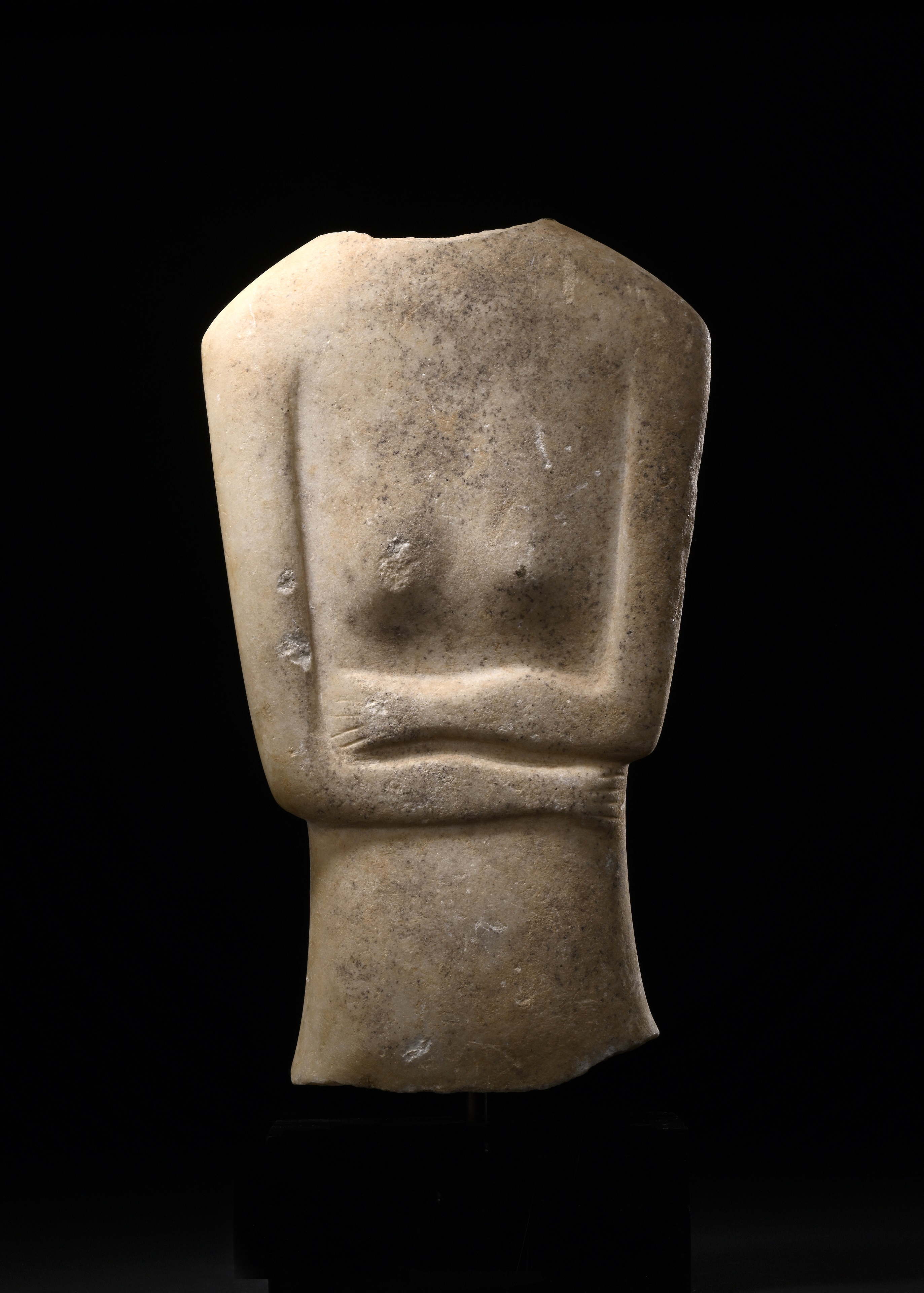
Monumental Cycladic Torso of an Idol, possibly by the Copenhagen Master, 2500-2000 B.C., Bronze Age, Greece, Marble, H: 32 cm. David Aaron Ltd
The enduring appeal of such figures lies partly in their ambiguity. Whether carved in marble, stone or formed from terracotta, these objects resist precise interpretation. It is presumed their purpose was religious or symbolic, but the exact meanings are largely lost. What does remain is an uncanny sense of presence, sharpened by the abstraction. Collectors of Piravend idols from the Caucasus or Amlash figurines from Iron Age Iran are drawn to the same qualities that captivate visitors to major exhibitions: a tension between the deeply ancient and the strikingly modern.
In recent years, museum exhibitions have helped people see the connections between ancient abstract idols from different parts of the world. By displaying figures from places like the Cyclades, Anatolia and Mesopotamia side by side, curators have shown that many early cultures shared a similar approach to representing the human form. The exhibition Idols: The Power of Images, held at the Fondazione Prada in Venice in 2019, assembled over 80 works from major archaeological museums and private collections; the curators traced a visual lineage of abstraction in human representation from the Neolithic period through to the 3rd millennium B.C.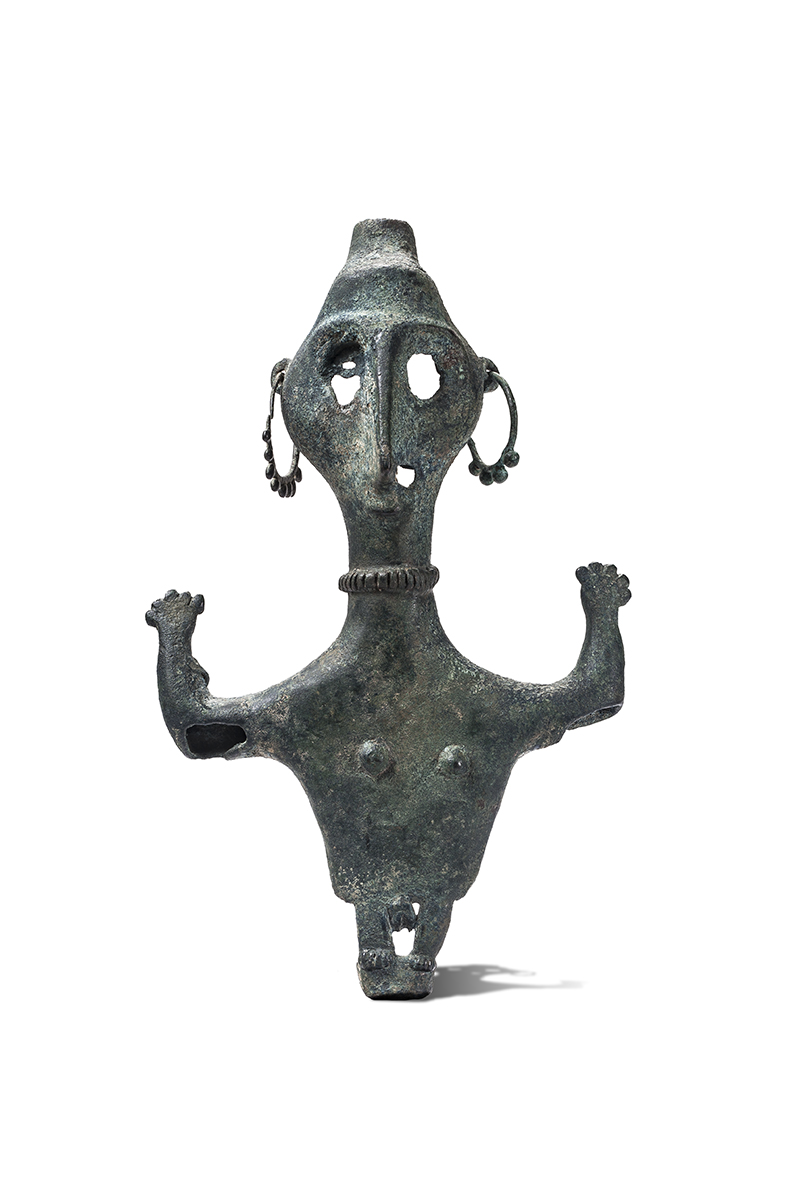
The ‘Gillet’ Piravend Idol, Iron Age II-III, Circa 1000-650 B.C., North-Western Iran, Bronze, H: 22.8cm, W: 14.3cm, David Aaron Ltd
Sir Leonard Woolley’s excavations at Tell Brak in the 1930s yielded hundreds of the so-called Eye Idols: small, flat stone plaques with exaggerated ocular features. These objects, believed to date from the 4th millennium B.C, have no known counterparts in contemporary traditions. Their stark design – geometric, linear and hypnotic – is one of the earliest attestations of abstraction in human form. In modern contexts, they could be mistaken for works by Paul Klee or Jean Arp.
This convergence has not gone unnoticed. The Cycladic figures of the Early Bronze Age Aegean, excavated in the early 20th century, had a formative influence on the European avant-garde. Artists such as Modigliani and Brâncuși drew directly from their smooth, faceless silhouettes. In the 1950s and 60s, major collectors including Stavros Niarchos and Christian Zervos amassed large groups of these works, recognising not only their archaeological value but their aesthetic resonance with post-war modernism.
Interest in such idols has persisted and evolved, collecting these objects often reflects a taste for the timeless: a desire to own works that embody the minimalism of form. Private collectors may acquire an Amlash terracotta idol as an ethnographic curiosity, and also as a sculptural object that could just as easily sit in a contemporary gallery. The art market has responded accordingly, with well-provenanced examples, especially from former major collections such as the Erlenmeyer or Niggeler, commanding strong prices due to their rarity and visual power.
Academic interest, meanwhile, has turned to broader interpretative frameworks. Scholars such as Colin Renfrew have argued for the importance of viewing these figures not in isolation, but within their original ritual and spatial contexts. Ultimately, the appeal of collecting abstract ancient idols rests on a paradox. These are the most silent of artefacts, mute, unknowable, contextually remote, and yet they speak directly to modern sensibilities. Their mystery is not a barrier but an invitation, and their reduction of the human form to its essentials continues to inspire a potent blend of scholarly respect and aesthetic fascination.

Monumental Cycladic Torso of an Idol, possibly by the Copenhagen Master, 2500-2000 B.C., Bronze Age, Greece, Marble, H: 32 cm. David Aaron Ltd
The enduring appeal of such figures lies partly in their ambiguity. Whether carved in marble, stone or formed from terracotta, these objects resist precise interpretation. It is presumed their purpose was religious or symbolic, but the exact meanings are largely lost. What does remain is an uncanny sense of presence, sharpened by the abstraction. Collectors of Piravend idols from the Caucasus or Amlash figurines from Iron Age Iran are drawn to the same qualities that captivate visitors to major exhibitions: a tension between the deeply ancient and the strikingly modern.
In recent years, museum exhibitions have helped people see the connections between ancient abstract idols from different parts of the world. By displaying figures from places like the Cyclades, Anatolia and Mesopotamia side by side, curators have shown that many early cultures shared a similar approach to representing the human form. The exhibition Idols: The Power of Images, held at the Fondazione Prada in Venice in 2019, assembled over 80 works from major archaeological museums and private collections; the curators traced a visual lineage of abstraction in human representation from the Neolithic period through to the 3rd millennium B.C.

The ‘Gillet’ Piravend Idol, Iron Age II-III, Circa 1000-650 B.C., North-Western Iran, Bronze, H: 22.8cm, W: 14.3cm, David Aaron Ltd
Sir Leonard Woolley’s excavations at Tell Brak in the 1930s yielded hundreds of the so-called Eye Idols: small, flat stone plaques with exaggerated ocular features. These objects, believed to date from the 4th millennium B.C, have no known counterparts in contemporary traditions. Their stark design – geometric, linear and hypnotic – is one of the earliest attestations of abstraction in human form. In modern contexts, they could be mistaken for works by Paul Klee or Jean Arp.
This convergence has not gone unnoticed. The Cycladic figures of the Early Bronze Age Aegean, excavated in the early 20th century, had a formative influence on the European avant-garde. Artists such as Modigliani and Brâncuși drew directly from their smooth, faceless silhouettes. In the 1950s and 60s, major collectors including Stavros Niarchos and Christian Zervos amassed large groups of these works, recognising not only their archaeological value but their aesthetic resonance with post-war modernism.
Interest in such idols has persisted and evolved, collecting these objects often reflects a taste for the timeless: a desire to own works that embody the minimalism of form. Private collectors may acquire an Amlash terracotta idol as an ethnographic curiosity, and also as a sculptural object that could just as easily sit in a contemporary gallery. The art market has responded accordingly, with well-provenanced examples, especially from former major collections such as the Erlenmeyer or Niggeler, commanding strong prices due to their rarity and visual power.
Academic interest, meanwhile, has turned to broader interpretative frameworks. Scholars such as Colin Renfrew have argued for the importance of viewing these figures not in isolation, but within their original ritual and spatial contexts. Ultimately, the appeal of collecting abstract ancient idols rests on a paradox. These are the most silent of artefacts, mute, unknowable, contextually remote, and yet they speak directly to modern sensibilities. Their mystery is not a barrier but an invitation, and their reduction of the human form to its essentials continues to inspire a potent blend of scholarly respect and aesthetic fascination.
Amlash Pottery
Published 06/05/2025
Read time: 5min
In Gilan Province in northwestern Iran, just south of the Caspian Sea, is a series of rich, fertile valleys, populated by olive and fruit trees, rice, wheat and barley plants. The valleys of this region hold many archaeological mounds, the remains of long-ago civilisations, from which a wealth of extraordinary objects of great historic and aesthetic interest have been unearthed. The Iron Age ceramics found around the modern town of Amlash exhibit a unique and easily recognisable style, and provide important archaeological evidence of an otherwise unrecorded civilisation.
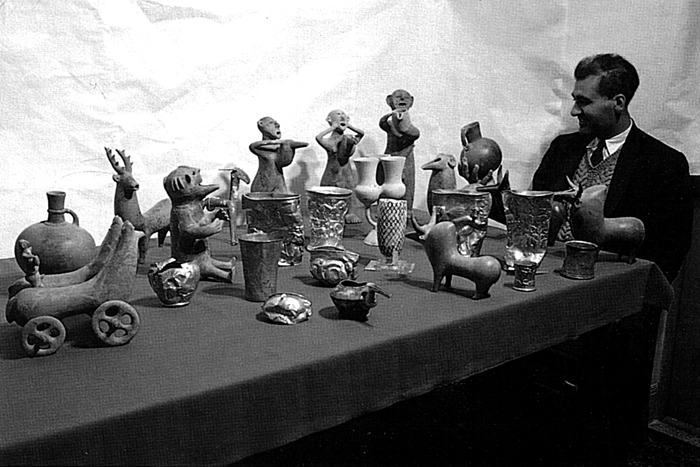
Ezat Negahban with finds from Marlik Tepe, The Encyclopædia Iranica
It quickly became clear that these archaeological remains provided evidence of a long-forgotten civilisation. In Negahban’s words, ‘we began to realise that we had discovered the burial mound of a culture that had completely vanished from human memory. The masterpieces of art discovered in these roughly constructed tomb chambers seemed to indicate that this must have been the burial ground of the royal families of this forgotten kingdom’. The objects Negahban discovered at Marlik were of such great variety that he said that if he hadn’t seen them emerge from the same site with his own eyes, he would not have believed it. The case has been made that some of the metalware and jewellery from these digs originated in earlier periods, or were goods traded from other cultures. It is, therefore, predominantly the ceramic vessels and statuettes which are deemed truly representative of Amlash culture.
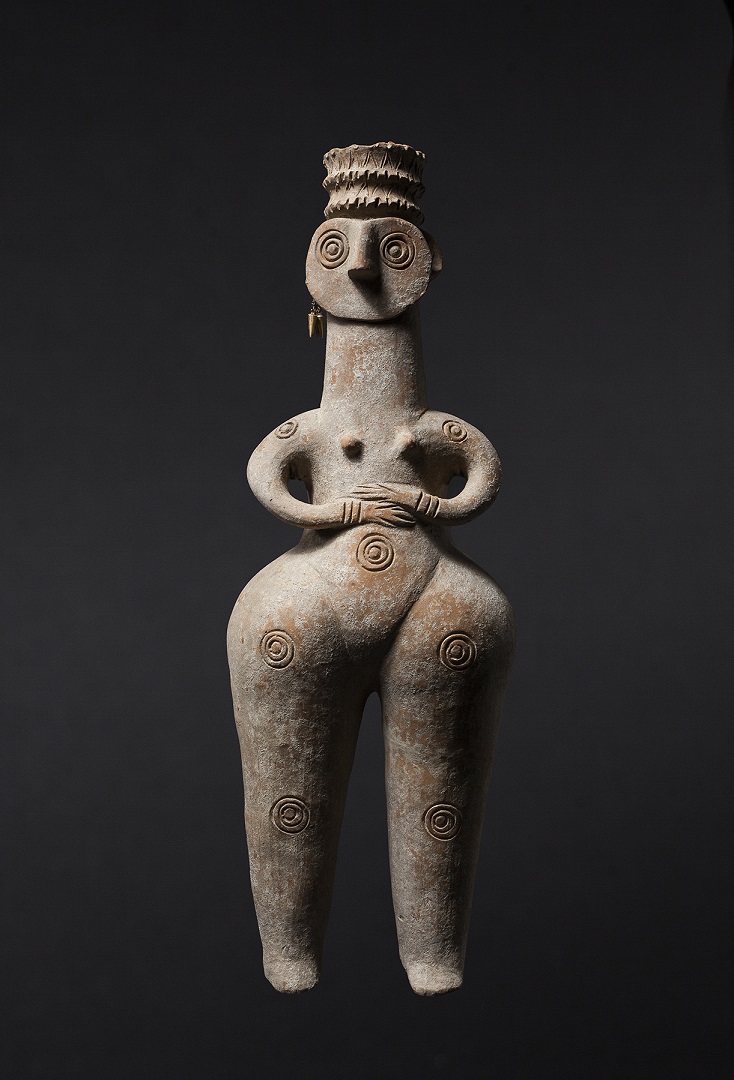
Amlash Idol, 1st Millennium B.C., Amlash, Central Asia, Terracotta, H: 45cm, David Aaron Ltd
The ceramic vessels and statuettes of both humans and animals from this region are by far the most important source we have on the Amlash culture of Iron-Age Iran. The many animal figures usually represent the region’s native fauna, such as rams, horses, stags, boars, oxen, and ibex. Human representations are also common and generally found at burial sites, suggesting that they may represent specific individuals or deities. Much of what has survived seems to have held spiritual or ritual functions, such as these votive idols, and libation vessels.
Since their appearance on the antiquities market in the late nineteenth and early twentieth centuries, Amlash ceramics have been of great interest to modern collectors and museums throughout the world. Their abstracted but immediately recognisable silhouettes appealed greatly to the early twentieth-century avant-garde. Artists were drawn to what they saw as a skilful reduction of figures to pure form. For instance, Pablo Picasso, who had been fascinated with the bull and bull-fighting from an early age, was known to have owned several bull-shaped libation vessels of Amlash type. A clear line of influence can be seen from these to Picasso’s ceramic works, such as his Standing Bull (1947).
In 1961, a large travelling exhibition of Iranian Art opened in Paris. ‘7000 Years of Iranian Art’ featured many fine examples of Amlash ceramics and metalwork, and brought them to the notice of the general public. Charles K. Wilkinson, then-Curator Emeritus of Near Eastern Art at the Metropolitan Museum of Art, wrote that, ‘Many of these objects of unglazed earthenware, grotesque in form and visually arresting, appealed strongly to people who ask of art something more than mere prettiness and mirror reflections of creatures and men of this world’. Although this was Amlash art’s Western debut, many of the pieces in the exhibition were loaned from private collections, where they had already been snapped up by keen connoisseurs.
One of the most arresting anthropomorphic Amlash figures to ever appear on the market is this large and intact steatopygous figure, 31 cm high, with an unmistakably female form, pictured above. Full hips swell below pronounced buttocks, tapering above to very narrow shoulders and thinning to two circular feet at the base. This produces a striking silhouette. The features are abstracted, with stylised limbs positioned below the two clearly modelled breasts. Five incised lines decorate the neck, probably representing jewellery, and small round ears protrude on either side of the head. The pierced ears may have originally been adorned with bronze or gold earrings, as other Marlik figures were.
This idol was one of the centrepieces of an exhibition of Amlash sculpture at Betty Parsons Gallery, New York, in 1963. Betty Parsons (1900-1982) was an American artist, art dealer, and collector known for her early promotion of Abstract Expressionism. Her New York gallery featured works by Jackson Pollock, Mark Rothko, Ad Reinhardt, Clyfford Still, and Barnett Newman, long before they achieved mainstream popularity. Invitees of her 1963 exhibition included cubist sculptor Jacques Lipchitz and Joseph Epstein, editor of The American Scholar. In the exhibition catalogue, Barnett Newman wrote that Amlash art is ‘unlike any sculpture known’ and that, ‘It is becoming more and more apparent that to understand Modern art, one must have an appreciation of the primitive arts, for just as modern art stands as an island of revolt in the stream of western European aesthetics, the many primitive art traditions stand apart as authentic aesthetic accomplishments’.
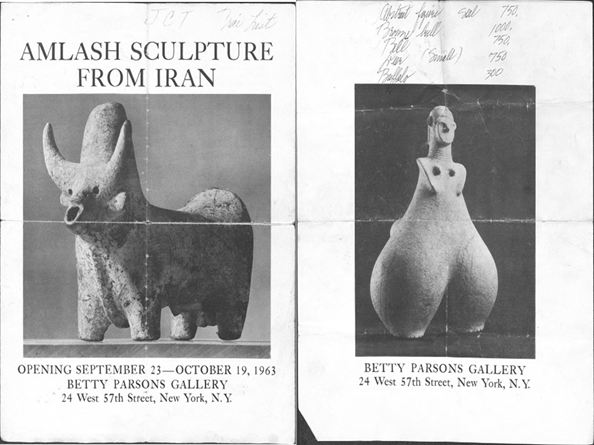
Poster advertising the exhibition curated by Betty Parsons, 1963
In 1964, the Jerrold Morris International Gallery, Toronto, possibly inspired by the positive press coverage of Parson’s exhibition, held his own exhibition of Amlash art. Many of the works featured in both exhibitions were lent by Samuel Dubiner and Barry Kernerman of Galerie Israel, Tel Aviv. Dubiner remains to this day one of the most preeminent collectors of Bronze Age Iranian artworks. In the 1970s, he produced, wrote, and narrated a series of short films about Amlash art entitled The Amlash Connection, featuring many pieces from his private collection.
Amlash ceramics continue to have a strong appeal today. Several examples featured in the 2021 ‘Epic Iran’ exhibition at the Victoria & Albert Museum, London, including a humped bull from the Ashmolean Museum and a steatopygic female figurine from the Sarikhani Collection.
Discovering Iron Age Amlash
Finds from this region have passed through the small market town of Amlash on their way into the antiquities markets of Iran, Europe and the US since the 1930s, prompting official excavations licensed by the Iranian government. In 1960, a team of Japanese archaeologists from Tokyo University led by Namio Egami excavated tomb sites in Deylaman. Here they found bronze and iron weaponry, horse equipage, mirrors, gold and silver jewellery, and bronze and ceramic figures of animals. Similar objects were found during the 1961 excavation of the Marlik tomb site on the Sefid Rud by renowned Iranian archaeologist Ezat Negahban. The fifty-three tomb chambers of Marlik Tepe, dated between 1100 and 800 B.C., contained many gold and silver vessels, weapons, jewellery, and grey- and red-ware ceramic vessels. Other ceramic finds from the nearby site of Kalaruz and the more distant Kalar Dasht share many characteristics with those found at Marlik.

Ezat Negahban with finds from Marlik Tepe, The Encyclopædia Iranica
It quickly became clear that these archaeological remains provided evidence of a long-forgotten civilisation. In Negahban’s words, ‘we began to realise that we had discovered the burial mound of a culture that had completely vanished from human memory. The masterpieces of art discovered in these roughly constructed tomb chambers seemed to indicate that this must have been the burial ground of the royal families of this forgotten kingdom’. The objects Negahban discovered at Marlik were of such great variety that he said that if he hadn’t seen them emerge from the same site with his own eyes, he would not have believed it. The case has been made that some of the metalware and jewellery from these digs originated in earlier periods, or were goods traded from other cultures. It is, therefore, predominantly the ceramic vessels and statuettes which are deemed truly representative of Amlash culture.

Amlash Idol, 1st Millennium B.C., Amlash, Central Asia, Terracotta, H: 45cm, David Aaron Ltd
Modern Fascination with the Ancient
Since their appearance on the antiquities market in the late nineteenth and early twentieth centuries, Amlash ceramics have been of great interest to modern collectors and museums throughout the world. Their abstracted but immediately recognisable silhouettes appealed greatly to the early twentieth-century avant-garde. Artists were drawn to what they saw as a skilful reduction of figures to pure form. For instance, Pablo Picasso, who had been fascinated with the bull and bull-fighting from an early age, was known to have owned several bull-shaped libation vessels of Amlash type. A clear line of influence can be seen from these to Picasso’s ceramic works, such as his Standing Bull (1947).
In 1961, a large travelling exhibition of Iranian Art opened in Paris. ‘7000 Years of Iranian Art’ featured many fine examples of Amlash ceramics and metalwork, and brought them to the notice of the general public. Charles K. Wilkinson, then-Curator Emeritus of Near Eastern Art at the Metropolitan Museum of Art, wrote that, ‘Many of these objects of unglazed earthenware, grotesque in form and visually arresting, appealed strongly to people who ask of art something more than mere prettiness and mirror reflections of creatures and men of this world’. Although this was Amlash art’s Western debut, many of the pieces in the exhibition were loaned from private collections, where they had already been snapped up by keen connoisseurs.
One of the most arresting anthropomorphic Amlash figures to ever appear on the market is this large and intact steatopygous figure, 31 cm high, with an unmistakably female form, pictured above. Full hips swell below pronounced buttocks, tapering above to very narrow shoulders and thinning to two circular feet at the base. This produces a striking silhouette. The features are abstracted, with stylised limbs positioned below the two clearly modelled breasts. Five incised lines decorate the neck, probably representing jewellery, and small round ears protrude on either side of the head. The pierced ears may have originally been adorned with bronze or gold earrings, as other Marlik figures were.
This idol was one of the centrepieces of an exhibition of Amlash sculpture at Betty Parsons Gallery, New York, in 1963. Betty Parsons (1900-1982) was an American artist, art dealer, and collector known for her early promotion of Abstract Expressionism. Her New York gallery featured works by Jackson Pollock, Mark Rothko, Ad Reinhardt, Clyfford Still, and Barnett Newman, long before they achieved mainstream popularity. Invitees of her 1963 exhibition included cubist sculptor Jacques Lipchitz and Joseph Epstein, editor of The American Scholar. In the exhibition catalogue, Barnett Newman wrote that Amlash art is ‘unlike any sculpture known’ and that, ‘It is becoming more and more apparent that to understand Modern art, one must have an appreciation of the primitive arts, for just as modern art stands as an island of revolt in the stream of western European aesthetics, the many primitive art traditions stand apart as authentic aesthetic accomplishments’.

Poster advertising the exhibition curated by Betty Parsons, 1963
In 1964, the Jerrold Morris International Gallery, Toronto, possibly inspired by the positive press coverage of Parson’s exhibition, held his own exhibition of Amlash art. Many of the works featured in both exhibitions were lent by Samuel Dubiner and Barry Kernerman of Galerie Israel, Tel Aviv. Dubiner remains to this day one of the most preeminent collectors of Bronze Age Iranian artworks. In the 1970s, he produced, wrote, and narrated a series of short films about Amlash art entitled The Amlash Connection, featuring many pieces from his private collection.
Amlash ceramics continue to have a strong appeal today. Several examples featured in the 2021 ‘Epic Iran’ exhibition at the Victoria & Albert Museum, London, including a humped bull from the Ashmolean Museum and a steatopygic female figurine from the Sarikhani Collection.







